A Progressive and Practical Approach to Education: Two Local School Districts Color Outside the Lines to Prepare Students for Real Life
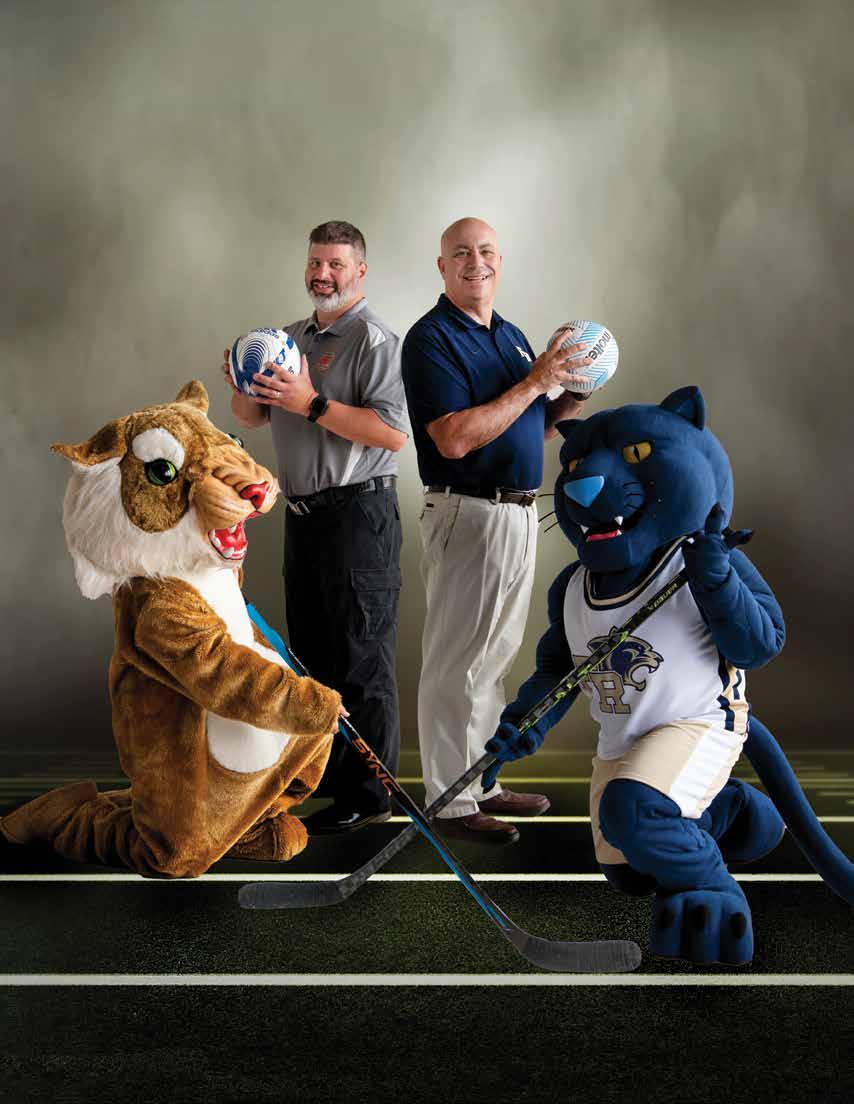
Subscriptions Available At: GO2GOALUS.COM MAGAZINE
INDIVIDUAL COMMITMENT TO A GROUP EFFORT | Summer 2023
Page 24
Please join us for the GOAL Magazine Golf Outing OR Paint -N- Sip to benefit the Greater Latrobe Partners in Education Foundation. Net proceeds will be granted to the Autistic Support, Learning Support and Life Skills Classrooms in the Greater Latrobe School District. Over the past seven years, we have raised more than $160,000 for this cause.






























The format is a 2- person scramble and the $175 entry fee per person includes a gift, snack box, lunch and beverages on the course, awards reception and dinner following golf PLUS chances to win top of the line prizes! The winning twosome will be awarded customized wrestling belts by Wildcat Championship Belts with the opportunity to present the belts to next year’s winners.









Dinner Only $50 Paint-N-Sip Only $60 Paint-N-Sip +Dinner $100 Starting at 11:00 a.m., follow a skilled instructor while you paint your own artwork. Sangria, creamsicle punch and heavy hors d'oeuvres are included with the Paint-N-Sip event. For more information visit www.go2goalus.com/events
Golf Outing Proudly Presents the 8th ANNUAL PLUS PAINT -N- SIP Magazine
Monday, August 14th, 2023 Arnold Palmer's Latrobe Country Club Registration 9:00 a.m. Tee Time Start 10:00 a.m. Dinner 3:00 p.m. $175 Per Golfer Not a golfer? Join us for Dinner or a Paint-N-Sip! Go2Goal is a Pennsylvania not for profit organization with a 501(c)(3) status with the Internal Revenue Service. The official registration and financial information may be obtained from the PA Dept. of State by calling toll free within PA at 800-732-0999. Registration does not imply endorsement. All donations are deductible in accordance with prevailing IRS rules. A portion of the registration proceeds will be tax deductible. Please consult your tax advisor. LEAD
SPONSOR:
Arnold Palmer's Latrobe Country Club
In this issue, hear from local Superintendents Michael Porembka of Greater Latrobe School District and Gennaro Piraino of Franklin Regional School District on how their districts are developing progressive educational programs that focus on preparing students for the future by giving them real world experiences and crafting curricular framework that allows students to meaningfully explore career pathways as early as elementary school.
Cover and Table of Contents photography captured by Autumn Stankay, owner of SkySight Photography in Greensburg, PA. Autumn is a celebrated commercial, portrait and wedding photographer with over 20 years of experience. Photography throughout the cover story was provided by the Franklin Regional and Greater Latrobe School Districts.
Five
Things People Need to Know About Estate Plans
by
Rafferty
Obesity The Curable and Preventable Killer by Dr. Jordan Ford, DC, Westmoreland Chiropractic and Rehab Associates

16 The Powerful Roman Empire by 1st Lt. Bradley D. Galbraith, Scout SniperPlatoon Commander, 3rd Battalion, 7th Marine Regiment
18 CASA of Westmoreland Advocating for the County’s Most Vulnerable Residents by Deanna Garcia, The Community Foundation of Westmoreland County
20 Addressing Pennsylvania’s Child Care Crisis Getting Parents Back to the Workforce by Dan DeBone, President/CEO Westmoreland County Chamber of Commerce
21 Let Us Guide You Through The Mortgage Maze by Jason L. McCoy, Westmoreland Home Mortgage
Home Services
32 Tax Treatment of Selling Collectibles by Bryan Kisiel, CPA Kisiel and Associates
34 A Photographer’s Guide to Maui by Autumn Stankay, SkySight Photography
Understanding the Many Choices in Healthcare by Allison Clayton, Insurance Services, LLC


37 Partnerships Key to EconomicDevelopment Efforts by Jason Rigone, Westmoreland County Industrial Development Corporation
38 Leadership Greater Latrobe Completes the Inaugural Year with a Bang by Briana Tomack, President Greater Latrobe Laurel Valley Chamber of Commerce
40 What’s Going on with My Rates by JJ Rettura, CIC Laurel Highlands Insurance Group, LLC


44 GOAL Magazine Gala Raises $22,200 for Shop with a Cop by Tawnya Rockwell, GOAL Magazine
46 An Evening of Fitness, Fun and Philanthropy with the Ladies of SHE by Tawnya Rockwell, GOAL Magazine
SUMMER
MAGAZINE
2023
24 Cover Story: A Progressive and Practical Approach to Education: Two Local School Districts Color Outside the Lines to Prepare Students for Real Life Coordinated by Bree Edgerly
Shafferslandscaping.com
Landscape Design Lawn & Garden Care Snow & Ice Removal 5 In Case you Missed It! by Tawnya Rockwell, GOAL Magazine 7 Improving the Health of Our Communities with Timely Licensing by Pennsylvania State Senator Pat Stefano (R-32) 8 Caring for Aging Parents by the SecondHalf Coach Wealth Management Team 10 Westmoreland County Children’s Bureau Foster Care by Westmoreland County Commissioner Gina Cerill Thrasher 11 This Summer’s Mental Health Care is in Your Own Backyard by Nicole O’Barto-Trainer, Ph.D, MS, LPC, Native 15 Brian’s Song Lives On by Bree Edgerly, GOAL Magazine 22 One Way to Take Care of Your Loved Ones When You Are Gone by Maria Graziano-Bickerstaff, Hartman-Graziano Funeral Home, Inc. 23 Headspace Media's Advertising Impact on the WIU Career Fair by Matthew Fridg, Headspace Media 28 Mother Nature’s Magic Wand by Ann Nemanic, GO Laurel Highlands 31 Tips for Downsizing by Scott Ludwick, Berkshire Hathaway
724.454.7034
12
6 42
Jessica Rafferty,
Legal, Esq.
Production Team
GO2GOAL is a 501(c)3 not-for-profit organization that is best known for publishing GOAL Magazine, which utilizes the talents of local business and community leaders to provide an authentic and informative resource to our community. However, we feel GOAL Magazine is more than a publication - it’s a movement!
GO2GOAL is deeply committed to giving back to our community by supporting a variety of nonprofit organizations via GOAL Magazine events such as our Annual Golf Outing PLUS Paint-n-Sip and Gala.
GOAL University GOAL University was created to bring the magazine to life and provide an outlet for our professional contributors
and other local professionals, who have a wide-ranging area of expertise, to present a curriculum for the public on a variety of topics.

SHE (Sophisticated | Humble | Empowered) is a female networking group founded by the women of Go2GOAL as a way to provide a forum for women to empower one another without judgment. SHE organizes purposeful social events that support local female-led businesses and bring awareness to local charities that help women and children.






Participation in GOAL Magazine can be rewarding in many ways. Not only do you gain an opportunity to promote your business through sharing your expertise and knowledge, you also become a proclaimed member of a collaborative group of local



leaders, entrepreneurs and professionals who are committed to bringing value to their community and giving back in meaningful ways.
How can I get involved? To learn how you can contribute to this publication, please email us at info@go2goalus.com.
How can I get my own copy of GOAL Magazine? The majority of GOAL Magazine recipients receive the magazine because one of the contributors within the magazine is sending the magazine as a gift, or currently subscribe.
Magazine subscriptions are available at go2goalus.com/subscribe.

4 GOALMagazine: A Publication of Go2Goal | Summer 2023
William J. Urbanik Co-Founder
Tawnya Rockwell Chief Production Manager
Bree Edgerly Writer
Jaimee Greenawalt Chief Designer
Autumn Stankay Photographer
Jessica M. Geary Co-Founder
Amanda Mayger Editor
Noele Creamer Editor
Kathleen Lloyd Editor
Anthony E. Slezak Co-Founder
MAGAZINE
What is GO2GOAL?
In case you missed it!
Here's a recap of our last issue ...
More than Just a Meal: Restaurants
with Purpose Beyond their Menu
For the Winter 2023 issue of GOAL Magazine released in January, we highlighted four local restaurant ventures where patrons can enjoy more than just a delicious meal. From an award-winning restaurant that is perpetuating the mantra “Drink Local,” to a cozy historical destination built on local heritage, to a former speakeasy whose walls whisper the scandalous stories of a century –GOAL Magazine toured around the riveting Westmoreland County restaurant scene.

The story was written by GOAL Magazine writer, Bree Edgerly and the food photography on the cover was captured by Autumn Stankay, owner of SkySight Photography in Greensburg, PA. Autumn is a celebrated commercial, portrait and wedding photographer with over 20 years of experience. Food images
shown on the cover were from the following local restaurants: Guy Fieri’s Live! Casino, Sports & Social Live! Casino, El Diablo, Hartwood Restaurant, J Corks, The Foundry Table & Tap, and Frick Park Market. The photos provided within the cover story were provided by the featured establishments.
We captured photos of the restaurant owners that were featured in the article with an oversized canvas of the cover at their establishments. A discount voucher was included within the article featuring the following deals valid through the end of 2023: buy 1 pizza, get 1 pizza ½ off at Marino’s American Eatery, a free coffee with meal purchase at the Getaway Café, and $1 off a banana split or milkshake at 512 Coffee and Ice Cream. Don’t let it go to waste and be sure to check out these amazing establishments!

Owner
View the entire article and the last issue of GOAL Magazine by scanning this QR code

1. Open your smartphone to the camera app.
2. Center the QR code in the frame.
3. View the entire magazine! The story starts on page 24.
Behind the vintage bar of the former speakeasy The Eastwood Inn, owner Drue Spallholz poses with the latest GOAL Magazine cover where he can commonly be found hanging out with his restaurant patrons, many of whom he knows by name.
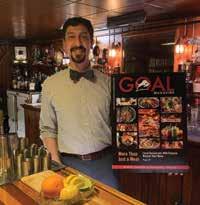
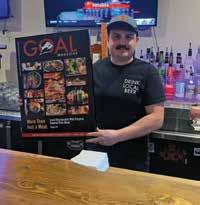
5 GOALMagazine: A Publication of Go2Goal | Summer 2023
If you missed this issue and would like to read more, visit www.go2goalus.com/ past-issues 5 www.go2goalus.com
Co-owner Josh Jones sports his “Drink Local Beer” Marino’s t-shirt behind the bar at the original Greensburg restaurant while showing off the GOAL Magazine cover.
Michael Ciotti’s friendly face is a regular fixture in the 512 Coffee and Ice Cream café in downtown Latrobe where he is proudly holding up the GOAL Magazine cover.
Five Things People Need to Know About Estate Plans
 by Jessica L. Rafferty, Esq.
by Jessica L. Rafferty, Esq.
People put off doing estate plans for many reasons. Some people hesitate to think about their death or incapacity (don’t get me wrong, I understand that it’s not a pleasant topic). Other people are intimidated by the idea of creating an estate plan because they aren’t sure what they need to know. To make it less intimidating, I thought it might be helpful to share 5 things you should know and consider regarding estate planning.
1. What should be in an estate plan? Every estate plan should have at least the following four components:
1. Last Will & Testament
2. Durable Financial Power of Attorney
3. Healthcare Power of Attorney
4. Living Will
Some people require or want additional planning (i.e., a trust, asset protection, etc.), but these four documents will give you a solid estate plan.
2. Last Will & Testament vs. Contracts
Your assets pass two ways when you die: under the terms of your Last Will & Testament or under the terms of a contract.
Contracts always supersede the Last Will & Testament. For example, if you have a life insurance policy and you name John as the
beneficiary of the life insurance policy, but in your Last Will & Testament you say that Sue is to receive everything — John will still receive your life insurance policy proceeds because that contract supersedes the terms of your Will.
3. Durable Financial Power of Attorney This gives a trusted person (i.e., your “agent”) the power to handle your property and finances if you become incapacitated. This incredibly important part of an estate plan will safeguard and manage your property if you cannot. Your agent ensures that as much property as possible is preserved, particularly if you need skilled nursing care. Having a Financial Power of Attorney also keeps your family out of court because, without one, often a guardian must be appointed for you by a judge.
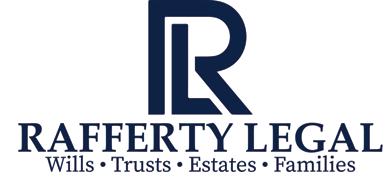
4. Healthcare Power of Attorney It appoints a trusted person (agent) to make decisions regarding your healthcare if you’re unable to do so yourself. If you cannot communicate your wishes, due to unconsciousness or any other reason, your agent will have the power to make decisions about what type of care you receive. This includes hiring and firing doctors and nurses, choosing medications, electing surgeries, and other healthcare-related decisions. Without a
valid Healthcare Power of Attorney, decisions regarding your care could lead to confusion and squabbling among family members. This confusion may cause delays or uncertainty at a time when you need effective treatment the most.
5. Living Will A separate document from an ordinary will, it’s sometimes called an “Advance Directive.” A Living Will directs doctors and other healthcare providers if you have an end-stage medical condition (something that will result in death despite treatment) or are permanently unconscious. Most clients indicate that they want their doctors to withhold lifesustaining treatment that only serves to prolong the process of dying. But many do want treatment that would alleviate pain. This gives your family peace-ofmind because you’ve told them what you want in your Living Will.
At Rafferty Legal, we believe everyone should have a plan that reflects what’s important to you. We’ll take the time to walk you through this process to make sure you and your family are protected. If you’d like to talk about your situation, please feel free to give us a call 724-520-2222 or visit our website (RaffertyLegal.com). We’d be happy to help you.
6 GOALMagazine: A Publication of Go2Goal | Summer 2023
IMPROVING THE HEALTH OF OUR COMMUNITIES WITH TIMELY LICENSING
by Pennsylvania State Senator Pat Stefano (R-32)
During my time in business, I learned progress is made through collaboration. A government that operates in silos does no one any favors. Since taking office, transparency and proper utilization of resources have always been among my top priorities, and I stand committed to making our Commonwealth operate as efficiently as possible.
At the onset of this legislative session, I was honored to be appointed chair of the Senate Consumer Protection and Professional Licensure Committee. Within this capacity, I have been tasked with overseeing legislation pertaining to Pennsylvania’s 29 professional and occupational licensing boards.

Following my appointment, I have engaged with various stakeholders across the Commonwealth to gain a deeper understanding of the challenges businesses face in the licensure process. Unfortunately, there’s a consistent problem my colleagues and I have seen for years: the significant delays health care professionals encounter when obtaining medical and other health care licenses.
I know firsthand about the impediments constituents face when applying for state-issued licenses, namely with the nursing and physician boards. Recent graduates eager to get to work or practicing professionals who are relocating to Pennsylvania from neighboring states often call my office, and sadly, it’s the same story again and again: they apply for their license immediately upon passing their exams or accepting a job, only to find themselves caught in a prolonged waiting game. Often, they find themselves waiting for months from when they intended to start working, and they’re still unable to do so.
These delays are beyond an inconvenience; they result in reduced availability of medical services,
disproportionately affecting underserved regions and exacerbating health care disparities. Patients are left grappling with prolonged wait times for appointments, jeopardizing their well-being. Furthermore, these systemic roadblocks discourage potential health care professionals from pursuing opportunities within Pennsylvania, further exacerbating staff shortages and hampering the delivery of quality care.
So, when public health is more critical than ever, one must inevitably question why our state bureaucracy stumbles in its efforts to get dedicated professionals into the workforce promptly.
It is evident that two primary factors contribute to the persistent delays.
Firstly, the Pennsylvania Licensing System (PALS), the portal through which all licensure applications pass, has proven to be far from the efficient and customizable system it promised to be upon implementation. Critics argue that it lacks user-friendliness for both applicants and processors, thereby hindering the swift progress of applications.
Beyond the shortcomings of this system, the second issue will be familiar to anyone in business right now: staffing. More than 50% of the positions at the Board of Nursing are vacant, as well as more than 40% in the medicine, osteopathic medicine, podiatry, and health licensing divisions. Even with the most efficient systems in place, the existing staffing shortfall renders meeting the demands of licensure applications across the Commonwealth an uphill battle.
The convergence of these challenges paints a rather bleak picture of our current predicament. Without professionals to process applications
promptly and an efficient software infrastructure, staffing shortages will continue to plague vital health care roles throughout the state.
Gov. Josh Shapiro’s administration has promised to provide immediate and long-term solutions to these delays and make customer service a top priority. All of that will have to start with staffing.
During an April public hearing on licensure delays, representatives from the Bureau of Professional and Occupational Affairs (BPOA) testified that they are understaffed and underpaid. Though the governor’s administration determines their hiring ability, funding for these positions are paid through licensure board fees, not general government funds. Because of that, the problem seems to be self-perpetuating.
The unfortunate truth is that here in southwestern Pennsylvania and across the state, we have properly trained people who want to work and help their communities. Yet, they are unable to get the necessary approval to do so from their own government.
As we grapple with this daunting challenge, the committee and I are committed to working with BPOA on both short and long-term goals. In the interim, we are expediting emergency licensure approvals, streamlining approval processes, and more clearly identifying to applicants where they are in the licensure process as well as what documents they may be missing. Long term, we are actively seeking efficiencies while investing in a new state-of-the-art licensure system to meet the needs of our Commonwealth and applicants with a seamless pathway to gainful employment.
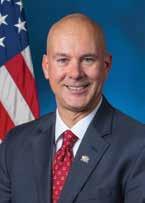
7 www.go2goalus.com
CARING FOR AGING PARENTS
by The SecondHalf Coach Wealth Management Team

Many adults have aging parents who are in need of healthcare and living assistance. There are a number of resources today that can help them grow old gracefully, either in their existing home or in a facility, along with multiple options for financing the cost of the care.
Living Options
Living alone
Depending on the independence of your parents, living alone in their existing house may be an option. However, you may need to make several modifications — some of them expensive — to make their home environmentally safe and suitable for an aging person.
For instance, important safety features such as a first-floor bathroom, grab bars in hallways and bathrooms, and an emergency response system may be necessary.
If your parent requires assistance with meals or chores, there are several services which can provide support, such as Meals on Wheels, which are free for anyone over 60.
You may also want to consider an inhome aide if your parent needs additional personal assistance.

Living with Family
Some families choose to move an aging parent into their own home. If you can do this with minimal conflict, this can be beneficial as it avoids having to maintain a second home — and of course can be less expensive. If your parent has
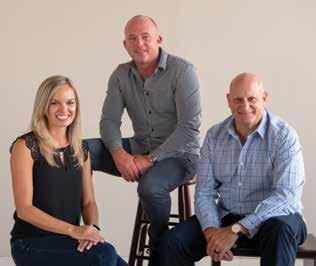
dementia or other health issues, adult day care can be helpful, as it allows them to socialize with other adults.
Assisted living
If your parents are independent and can care for themselves, they may be eligible to enter a continuing-care retirement community, where they can rent (or purchase) an apartment and be eligible for nursing care, if it becomes necessary. Consider purchasing long-term care insurance, which can help pay for nursing home costs or the cost of an in-home aide.
Nursing home
If your parents need more extensive care and require a nursing home, research the options extensively. You may need to reserve a space far in advance, as waiting lists are often long at popular facilities. The government provides limited financial assistance for families paying for nursing home care. Financing long-term care can be a tremendous challenge for many adults.
Financing Long-Term Care




Medicare will only pay the full cost of professional help if a physician certifies that your parent requires nursing care and if the services are provided by a Medicarecertified home health care agency. However, Medicare will pay for nursing home care for the short-term only, with benefits restricted to low-income individuals with limited assets.
You can offset some of these costs, as you can claim a federal tax credit up to $3,000 off the cost of in-home care or day care.
You can use a flexible spending account, too, which helps you pay for a certain amount of covered expenses with pretax dollars.
With the cost of elderly care continually on the rise, financial planning can be an important step in providing adequate support for your parents’ future well-being

9 www.go2goalus.com 8 GOALMagazine A Publication of Go2Goal Summer 2023
Securities and advisory services offered through LPL Financial, a registered investment advisor. Member FINRA/SIPC. This material is for general information only and is not intended to provide specific advice or recommendations for any individual. There is no assurance that the views or strategies discussed are suitable for all investors or will yield positive outcomes. Investing involves risks including possible loss of principal. This material was prepared by LPL Financial,
2519 Ligonier St. P.O. Box 421 Latrobe, Pa 15650 724.537.2799 www.shcwealthmanagement.com info@shcwealthmanagement.com SecondHalf Coach Wealth Management SecondHalfCoachWealthManagement SHCteam Jessica M.
J.
LLC
Geary, CFP®, William
Urbanik, MBA and Anthony E. Slezak
There are important steps you can take to help your aging parents find health care and living assistance, and to secure financing for the cost of the care.
The government provides limited financial assistance for families paying for nursing home care. Financing long-term care can be a tremendous challenge for many adults.
Westmoreland County Children’s Bureau Foster Care

There are approximately 257 children in out-of-home placement on any given day in Westmoreland County. The lack of foster homes is an ongoing crisis and help is needed. Capable and dedicated foster families are needed in every neighborhood in Westmoreland County to provide a loving home for children in need.
The Westmoreland County Children’s Bureau makes every attempt to place siblings together and keep children in their current school district, so they can remain in their familiar community and have the least amount of disruption in their lives. However, the agency confronts many daily challenges in trying to manage actively arising circumstances.
Until a local certified foster home can be located, children may have to stay at the Youth Shelter or a group home. Three infants from three different families were recently in need of a foster home within the same week. Circumstances such as foster homes not having any openings, conflicts with foster parents’ work schedules, and conflicts with biological family visits made placing them difficult. Children who are too young to be placed in one of these facilities often must stay in the offices of the Westmoreland County Children’s Bureau.
When I requested information regarding the foster care program, I received this information from a supervisor: “We recently had a difficult time finding a foster home for siblings who were 4 and 5 years old. Through no fault of their own, they were not permitted to go back home with their father. The children and child welfare employees stayed after hours to locate a foster home. At 6 p.m., a home
was found through another agency in the Pittsburgh area. It was an hour and a half from their home. Because there were no local foster families to take in the siblings, the caseworker had no choice but to place them there. This impacted the children tremendously. It took them away from their normal routine, school, friends and family, which added to their existing trauma. Having more local foster families with the ability to take in siblings would alleviate this type of situation.”
The foster care supervisor went on to describe another type of struggle. “We also had a 12-year-old male with Cerebral Palsy needing a foster home. He was charming, polite, smart and funny, and did not have any behavioral issues, but due to being wheelchair bound and requiring special needs, he had to remain in the hospital longer than medically necessary. He spent a night in our shelter until we could locate a foster home. It is very sad when we cannot locate foster families for children, and I’m sure the longer it takes, the more hopeless the children feel.”
By Gina Cerilli Thrasher, Westmoreland County Commissioner

Last year, Westmoreland County Children’s Bureau served approximately 6,062 children ages newborn to 21. While many children are able to remain in their home while services are completed, in 2022 approximately 343 children were in a foster care setting to keep them safe. Some have returned home, some have gone with family, others have been adopted or have reached the age of majority and live on their own. There are also some who continue to remain in out-of-home placement. Of the children unable to return home at this time, 33 children ages 3-18 are waiting in youth shelters, group homes or other temporary placements. This number does not include youth over 18 living in their own apartment, even though they are technically in foster care. The typical age for youth waiting for placement is 12-18, but homes are needed for children ages 0-21. There is also a need for people to serve as supports for the older youth living on their own.
Fostering comes with a lot of expectations and challenges, but it can also be very rewarding to help make a difference in a child’s life. The first step to becoming a foster parent is to attend a Foster Care Information Session to hear about the program, ask questions and find out if fostering might be a good fit for you, your family and the agency.
Anyone willing to become a foster parent and offer any type of assistance, please reach out to the Westmoreland County Children’s Bureau at 724-850-6884. Visit https://www.co.westmoreland.pa.us/383/ Foster-Care-Resource-Homes or call 724830-3127 for more information and to schedule for an upcoming informational session. Westmoreland also subcontracts with 18 other foster care agencies.
10 GOALMagazine: A Publication of Go2Goal | Summer 2023
Six of the agencies' children find their home with a local family: Photo courtesy of Westmoreland County Children’s Bureau
This Summer’s Mental Health Care is IN YOUR OWN BACKYARD
 by Nicole O’Barto-Trainer, Ph.D., MS, LPC
by Nicole O’Barto-Trainer, Ph.D., MS, LPC
The arrival of summer brings longer days, sunny skies and cool evenings, conditions that beckon us outdoors. However, getting and staying outside has become less and less common today. In fact, studies have consistently found that Americans spend increasingly more time indoors. Some report that Americans spend up to 22 hours a day and up to 93% of their lives inside. These statistics raise questions about the impact the lack of time spent outdoors, specifically in nature, has on the developing child and the overall health and wellbeing of children and adults alike.
In 2005, journalist Richard Louv created and popularized the term “nature-deficit disorder” when he published Last Child in the Woods: Saving Our Children from Nature-Deficit Disorder.
Louv said he “coined the phrase to serve as a description of the human costs of alienation from nature.” Louv’s theory has been adopted by parents around the world to help discuss the difference between their childhoods and those of their children growing up in the modern, and increasingly digital, world.
The theory applies to both adults and children, but the message has resonated strongly with parents because many children are growing up while spending an unprecedented amount of time inside for the first time in human history. In fact, the average American child spends as few as 30 minutes a day in unstructured outdoor play and as much as seven hours a day in front of an electronic screen.
Louv posits that the disconnect from nature created by spending so much time inside can have numerous negative effects on mental and physical health. These include weaknesses in executive functioning; compromised immune functioning including an increased risk of asthma, allergies, and autoimmune conditions; essential micronutrient deficiencies; increased risk for depression and anxiety and obesity.

Nature deficit disorder is not intended to be a diagnosable mental or medical health condition. However, it highlights how present-day living conditions have caused humans to become disconnected from the environment and nature. And it draws attention to the potential emotional and physical costs associated with such disconnection.
So, this summer, recall the words of your own mother and tell your kids to “go play outside!” Their minds and bodies will thank you for it!
Some ways that spending time in nature can be beneficial include:
· Improved Executive Functioning Skills commonly associated with attention-deficit disorder — like attention span, multitasking, problem-solving,
prioritizing, and age-appropriate risk-taking — are strengthened through unstructured free play in nature.
· Sensory Engagement
The experience of spending time outside and enjoying outdoor activities engages all five senses. A child who grows up playing in the natural world will use their senses more than one who spends their playtime inside. Sensory engagement is associated with decreased levels of stress and anxiety, improved problem-solving skills, and creativity.
· Increased Vitamin D Levels Spending time in the sun is a great way to soak up vitamin D. Regularly staying inside for most of the day can quickly lead to Vitamin D deficiency. Vitamin D is an essential micronutrient for health and wellbeing. Deficiencies in Vitamin D have been linked to fatigue, depression, bone pain, hair loss, and depression/low mood. Maintaining optimal levels of Vitamin D boosts your immune function and lowers the risk of developing cancer, heart disease, and diabetes.
· Decreased Rates of Obesity
The more time a child spends outside engaged in various forms of outdoor exercise, the lower their risk of obesity. Conversely, children with more sedentary indoor lifestyles have an increased risk of obesity.
· Improved Sleep Spending time playing outdoors increases a child’s exposure to natural light, which can have a positive effect on sleep. It is also a natural form of stress and anxiety relief, which can also help kids sleep better.
· Stronger Immune Systems Quite literally, playing in dirt supports our immune system. There are real benefits to getting dirty, playing outdoors in nature. Dirt exposes us to healthy bacteria that can boost the diversity of our gut microbiome and strengthen our immune response.
11 www.go2goalus.com
OBESITY
The Curable and Preventable Killer
Summer is here and being overweight can hurt much more than your beach body. According to the CDC, a vast majority of the leading causes of death have a strong link to obesity. Your chances of developing heart disease, cancer, stroke, and respiratory illness all increase when you have an elevated BMI (Body Mass Index). Carrying excess weight can also play a huge role in your mental health, and lead to conditions such as anxiety and depression. Obesity can drive up health care costs, decrease quality of life, and decrease your life expectancy. If you have added some weight over the last few years, don’t worry because you aren’t alone. It is estimated that over 40% of Americans struggle with obesity, and that number has been steadily increasing over the last 20 years.
Okay enough with the negativity. The one good thing about obesity is that it is curable and preventable. Most of us have packed on
By Dr Jordan Ford DC


a few pounds during the pandemic, but now the world has opened back up and it’s time to live our best lives. There are no quick fixes, and it will take dedication and discipline, but here are a few tips that can make you look and feel better.


A Calorie-Controlled Diet
Obesity is typically caused by eating more calories than you burn through physical activity. The question you should be asking is “how many calories should I be eating?” There are plenty of resources out there which can provide you with your estimated Total Daily Energy Expenditure (TDEE). This calculation will provide with you with a rough estimate of how many calories your body is burning each day. Once you find this number then it’s time to start tracking your calories. If you have questions about how many calories you should be eating, then it is important to consult with a health care professional.
Cut out the Junk. Once you start counting your calories, most people will start to realize how quickly they add up from eating processed and sugary foods. Added sugars are filled with “empty calories”, which provide none of the essential nutrients that your body needs. These sugary foods are also low in protein and leave you feeling hungry and unsatisfied. Eating foods high in protein will help to increase your appetite reducing hormones, which will reduce your hunger hormones. Proteins also have a much higher thermic effect of food, which will help boost your metabolism.
Burn Baby Burn
Every single person is different and there are no cookie cutter methods to weight loss. We all have limitations of how much we can do physically due to our age and illnesses. It’s important to understand your own body and what you are capable of when it comes to physical activity. Although we all have our differences, each of us can benefit from movement and exercise. Being active will help to strengthen muscle, increase bone density, improve brain health, and reduce the risk of chronic illness. The more physically active you are, the more calories your body will burn.
Hormones Play a Role
If you have been trying for years to

reduce calories and increase your physical activity with limited results, then it’s possible that something else is limiting your weight loss. Hormones are critical in controlling your appetite and metabolism. If your body is releasing irregular hormone levels, then it can be very difficult to lose weight. Age, body weight, medical conditions, and medication can influence your hormone levels, so it is vital to look at your body as a whole. Factors such as inadequate sleep and elevated stress levels can throw your hormone levels into a tailspin. If you are taking all the right steps and still having problems losing weight and feeling healthy, then getting your hormones check can be vital.
Obesity is quickly becoming one of the largest health concerns across our communities. Often times it’s more convenient to grab something quick and unhealthy, than to put the effort into making a well-balanced meal. Sitting down on the couch with a bag of potato chips is much easier than going for a walk after work. Being healthy isn’t easy, and there is no magic pill that is going to fix all of your problems. Each and every person is different, and health shouldn’t be a one size fits all subject. If you have questions about your body, then take the next step and sit down with a health care professional.
13 www.go2goalus.com 12 GOALMagazine A Publication of Go2Goal Summer 2023
Greensburg
Export
nelsonchirorehab.com @WestmorelandChiropractic
Office 724.216.5004
Office 724.325.2112
Dr. Jordan Ford is an Associate Chiropractor with Westmoreland Chiropractic & Rehab Associates.
Eating foods high in protein will help to increase your appetite reducing hormones, which will reduce your hunger hormones.
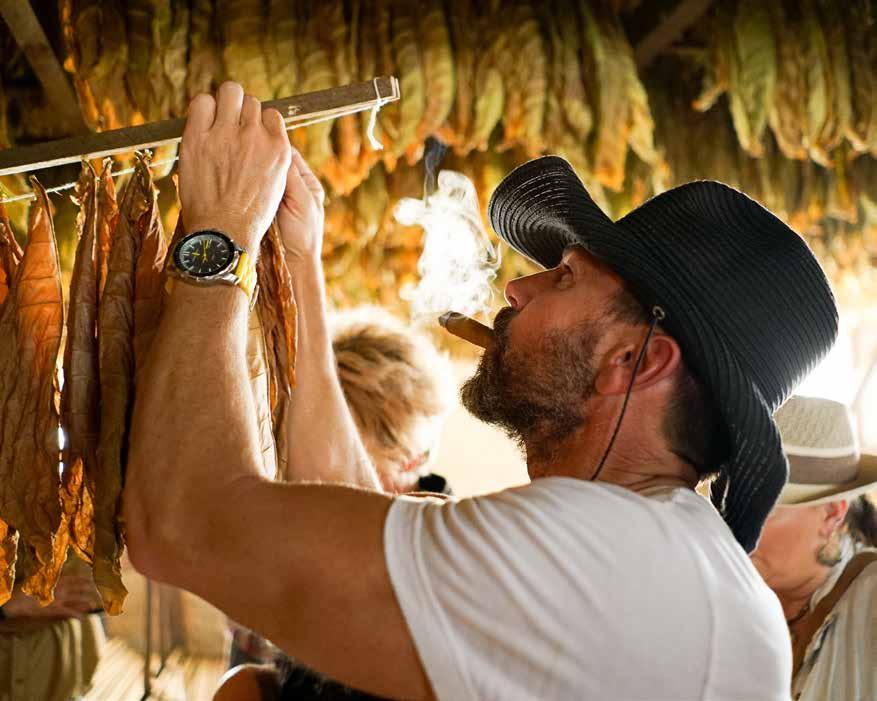
Greensburg Location Walk-In Humidor, Retail, and Aladino Lounge 645 Mount Pleasant Street Greensburg, PA 15601 724.217.8042 Norwin Hills Shopping Center Location Walk-In Humidor and Retail 8775 Norwin Ave Irwin, PA 15642 724.515.5818 Nlcigar.com Reed Nelson Loguasto 724.516.7777 Selling nationwide at route30cigars.com Hand Rolled Premium Cigars
Brian’s Song Lives On
by Bree Edgerly
On a sunny hillside nestled into the farm lands of Westmoreland County, Peach Park is home to the Brian T. Rusnock Amphitheater where people have been able to gather for the past 9 summers to enjoy performances in the park. The most popular concert series featured at the amphitheater, the Twin Lakes Park Summer Concert Series is currently in full swing and offers free admission for patrons of all ages to enjoy hours of local music with access to beverages from Unity Brewing and eats from Lou Lou’s Smokehouse. The 2023 lineup boasts 21 local bands over a span of 9 summer weekend dates and is sure to offer a genre of music for everyone’s taste.
How the Brian T. Rusnock Amphitheater came to be named is a special story perhaps not known to all who frequent the park. On April 13, 2008, Latrobe native Brian T. Rusnock unexpectedly passed away at 22, leaving his big family and a whole community of people his life had touched crushed by the tragedy. Brian was just 3 weeks from graduating college and stepping into his career as a woodshop technical education teacher. His father Thomas Rusnock

Your gentle spirit, big heart, and warm smile touched so many lives in such a short time. The enthusiasm in which you lived life brought joy and laughter to every person you met. Playing music was such a big part of expressing that enthusiasm. Here your passion as a musician can be enjoyed by all who share that same love of music.
“Your Song Lives On”
described Brian as the most kind and gentle person, always with his arm around someone for whom he cared. The huge presence at his funeral was a small testament to the impact he had on those who knew him, including over 150 of his students who had only just known him during his several months of student teaching.
Confronted with the ultimate nightmare of losing a child, Tom and Annette Rusnock and Brian’s sister Kelly positively concentrated their efforts to honor Brian’s life and make sure that he was never forgotten. They were beyond grateful when Annette’s brother Randy Stas, a board member of the Westmoreland County Parks & Recreation and chairperson for the annual March for Parks event, approached them in 2009 to form a team in Brian’s memory and participate in the parks fundraiser. Then in 2013, they were approached by the Parks Director, Malcolm Sias, with an opportunity to name the new amphitheater planned as part of the Twin Lakes Park Expansion Phase III after Brian.
Brian had been a very talented musician through most of his life. Music came naturally to him – he picked up piano around age 7 and learned the guitar on his own through his teenage years. From playing at home with his dad who is a drummer, to his neighborhood jam group with a couple of his close friends (who officially formed a band named Life of Brian after his passing), to his college band R&R Express at California University, he was always eager to share his music wherever he went. Tom, Annette and Kelly felt that the amphitheater, a place where music would be enjoyed by the masses for many years to come, was the perfect place to keep Brian’s memory and music alive.
For the 2009 March for Parks fundraising event, they banded together with family and friends to form Brians’s Brigade, a team that has raised nearly $120,000 to date to support the park system and trail projects of Westmoreland County. In 2013, they also started Brian’s Brigade Band Fest, an annual fundraising concert through 2016 that raised over $28,000 in just four years specifically to finish funding the new amphitheater. Between the March for Parks event and Band Fest, the outpouring of support in Brian’s memory led to the official dedication of the completed Brian T. Rusnock Amphitheater on July 11, 2015.

The free concert series and continued improvements of the amphitheater, such as the $23,000 new stage lighting project currently underway, are annually funded in part by the Westmoreland County Parks, sponsorships from local businesses and generous donations from concert attendees. Rising from the grips of tragedy with the support of a strong community, the Rusnock’s have successfully perpetuated their son’s legacy through a beautiful community music venue. Honored in song for years to come, Brian’s memory lives on in the hearts of those he touched and those who may have never known him, but gather annually to enjoy the admirable efforts of his community.

Open the camera on your smartphone, scan the QR code and follow the link for details on the Summer Concert Series.

15 www.go2goalus.com
by 1st Lt. Bradley D. Galbraith, Scout Sniper Platoon Commander, 3rd Battalion, 7th Marine Regiment

The Powerful Roman Empire
At its height, the Roman Empire was the most powerful civilization in the Western world. Even today, many of the empire’s influences can be seen in almost every aspect of society.

The ideas that came from the empire are often attributed to the flow of different cultures throughout the territories colliding and sharing their thoughts and opinions.
The expansion of the Roman Empire is in large part due to the military power that the Romans had. The strengths of the military included its size and organization among its ranks, as well as a specialized corps of engineers to help men like Alexander the Great navigate the grand army. Because of the strengths of the military, and Alexander the Great’s desire to expand his empire, The Roman Empire was one of the greatest civilizations the world has ever seen.

The Romans were known for being able to cross into new territories very rapidly.
The Roman Empire at its territorial height in AD 117 held lands that stretched throughout what is today parts of Africa, Asia, the Middle East, Europe, and the United Kingdom. Additionally, the empire was at its most effective during the conquests of Alexander the Great, using his vast resources to traverse Europe at alarming rates. Of all the tools at his disposal, the empire’s greatest asset was its military might.
13 to 21 feet, and was massed in squares sixteen rows deep and wide. This formation, integrated with physical prowess and advanced weaponry, saw wave after wave of enemies crushed attempting to repel the dreaded phalanx.

In addition to the well-armed infantry, they were even a better trained cavalry. The cavalry, men mounted on horseback, were traditionally the eyes of the army. Able to ride days in advance of the main body, the cavalry could report enemy movements, as well the upcoming terrain. This allowed commanders to shape when and where battles would take place before they had even occurred. More importantly, mounted soldiers allowed for quick maneuverability on the battlefield and could crush the enemy with their skill and speed. These specializations, combined with the size and organization of the army, made it almost impossible for the Roman army to be defeated.
The Roman Army itself had many strengths that made it such a dominant military force, but none of these strengths were more notable than the army’s size and specific organization. Because the empire was great in size, men within it were broken down into specific jobs and ranks. This made it so leaders of the army could regroup easily if they suffered a great number of casualties in battle. This was hardly ever necessary, however, because the army was so well organized that most modern militaries, including the United States, can trace their roots back to the Romans. The jobs soldiers could hold can be broken down into a few pronounced categories. The army was primarily infantry, men who fought on foot with their pikes, swords, and daggers. Generally the infantry used these pikes to fend off the first wave of attackers in a formation called the Macedonian Phalanx. The infantry was armed with twohanded pikes of graduated lengths, from
A prospective attacking enemy would have to contend with Roman catapults and archers raining armament on their position, forcing them into what we the modern military calls the combined arms dilemma: stay in position and die from arrows and rocks raining on your position, or advance into the feared phalanx and be slaughtered in even larger numbers. Once forced into this dilemma, enemy commanders would inevitably retreat or advance to provide relief from the incoming barrage. Then, once the enemy was occupied at the hands of the infantry, the highly maneuverable cavalry would flank the panicked masses, and clean up whatever enemy remained.
To complement the effective attacks of the infantry and cavalry, the Romans utilized cutting edge military engineering to sweep across land faster and more effectively. The Romans would construct well-fortified camps at any given place, allowing the army to have a comfortable traveling home
anywhere from three to four days. The engineers within the army were relieved of normal duties in order to complete tasks such as building bridges where rivers became narrow so that the army could advance within a matter of days. It was also very common for engineers to construct roads so that the army could receive fresh soldiers and supplies from major outposts in a timely manner. The Roman engineers cannot be overlooked in the role they played in allowing the army to navigate much more quickly and effectively across Europe. Therefore, as with most armies throughout the centuries, the Roman Army’s critical vulnerability was its ability to establish and control supply lines that could facilitate a rapid expansion.
What many often question, however, is why Alexander felt it was necessary to expand his territory so quickly and extensively? Besides the obvious reasons that one would assume come with new territory, Alexander sought more than one would expect. He had inherited Greece, and pushed its ideologies outward as far as North Africa and India. Alexander encouraged the idea of blending all the conquered cultures together into one Hellenistic culture. In addition to the resources that were acquired from the territories gained, coastal cities allowed for smoother transport of goods within the empire. The expansion not only helped with the flow of goods, but also the flow of ideas. Scholars could now move about
the empire and share ideas, feeding off of one another to advance what they knew. To further the idea of blending cultures, Alexander instituted an intermarriage policy where soldiers in the Roman army could marry conquered people and settle where they pleased when their service with the army was no longer required. Alexander himself began to adopt some ideals foreign to Rome by wearing “barbaric” traditional Persian dress. His expansion finally ceased when his exhausted army refused to go on, thousands of miles and eight years from home. Although Alexander died a mysterious and untimely death, his empire's advances in art, science, engineering, and culture can still be seen in the modern world.
The Roman Empire is undeniably one the most dominant empires of its time. In addition to its fascinating culture, The Roman Empire was able to conquer much of Europe through its then elite military. At its peak, The Romans were able to control the majority of the land from the United Kingdom to the Middle East. Because the Romans were able to pinpoint their strengths, they were able to dominate the civilized world. These strengths of the Roman army allowed them to expand their territories so extensively.
16 GOALMagazine A Publication of Go2Goal Summer 2023
These specializations, combined with the size and organization of the army, made it almost impossible for the Roman army to be defeated.
than $222,000 in grants have come from The Community Foundation of Westmoreland County.
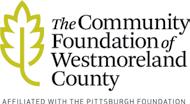
“CFWC is proud to support the critical work of CASA and its volunteers,” says McCrae Martino, CFWC executive director. “The agency is a tremendous asset to the County in ensuring children have a voice in a system that can often be confusing and scary for them.”
Upcoming CASA Events
CASA Westmoreland hosts numerous events throughout the year to raise funds and awareness for the program.
Dennis W.
demonstrates how he and other advocates support their court-appointed case children.
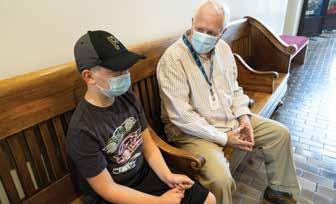
CASA OF WESTMORELAND Advocating for
The “CASA” in CASA of Westmoreland is an acronym: Court Appointed Special Advocates. They are trained volunteer advocates for children who have involvement in Westmoreland County Children and Youth Services. These children are often abused and neglected. Typically, each volunteer is assigned one child and they are with that child until some sort of permanence is achieved such as adoption or reunification with their family. The volunteers communicate with everyone involved in the child’s case, write a court brief, and speak on the child’s behalf in court.
“In human services work, there can be a lot of turnover – it’s hard and heavy work,” says Mitchell Samick, executive director of CASA of Westmoreland. “Our volunteers meet regularly with the children but also work with everyone involved in their case including teachers and therapists. Sometimes, that volunteer will have known
the child longer than any other service provider in their life. That consistency helps ensure that the child’s needs are being met and it gives them a voice in a system that can be overwhelming.”

CASA Westmoreland is part of a national organization that started in Seattle in 1977. One year prior, Seattle Juvenile Court Judge David W. Soukup had to make a life-changing decision for a 3-year-old girl who had been abused. The organization’s website states that Judge Soukup had insufficient information to make that decision, leading him to the idea that children who had experienced abuse or neglect needed trained volunteers speaking up in the courtroom for their best interests.
In Westmoreland County, the CASA program was initiated by a group of community members, led by Family Court Judge

Christopher Feliciani. Through the work of a steering committee, board of directors and the support of the community and Westmoreland County commissioners, the organization began advocating for children in 2007.

Samick has been involved with CASA for about nine years and became executive director in November 2022. A professional staff of nine ensures that CASA advocates are recruited, trained, supervised and supported during their time working with children, who can range in age from birth to 21 years. Anyone in the county can become a volunteer, as long as they are able to complete the 30-hour training offered by CASA of Westmoreland.
“They are sworn in by a family court judge and assigned to one case, for the duration of that case,” says Sammick. “In 2022, 158 children were served by 82 volunteers.”
Like many nonprofits that rely on volunteers, one of the challenges faced by CASA is recruitment. Currently, most of the volunteers are in Greensburg and Latrobe in central Westmoreland County. But the county is huge, and the hope is to ensure that volunteers are assigned cases that fall within their geographic areas. He says currently more people are needed in the New Kensington and Ligonier areas, but adds that, in general, there is always a need for advocates from any area. CASA of Westmoreland relies on grants, donations, and sponsorships for the majority of their funding. In 2022, for the first time, CASA programs were included in the state budget, and the hope is that will be the case again this year. Since 2012, more
Samick says the organization is always open to going to different businesses, civic groups, or churches to spread the word about the program and its importance for children. As the effort continues to recruit volunteers, he says word of mouth is critical.
There are three volunteer class cycles per year, and the training and materials are free for volunteers. It’s a five-week course that follows the national CASA curriculum covering cultural competency, mental health, the human services system, substance abuse and more. A training started on May 2 and the next starts at the beginning of September.
“Our future is bright,” says Samick. “The COVID years were hard. Funding was affected but our advocates remained committed and strong and have always done what they need to do for the children. Our relationships with community partners remain strong and we’re hopeful that we can continue to serve children in need."
JUNE 22
CLAYS FOR KIDS
A sporting clay shoot event Nemacolin Field Club Registration begins at 8:30 a.m.
AUG. 25
ANNUAL GOLF & TENNIS TOURNAMENT
Latrobe County Club Information at casaofwestmoreland.org/events
NOV. 11
ANNUAL CASA GALA
The Club at Blackthorne Information at casaofwestmoreland.org/events
18 GOALMagazine A Publication of Go2Goal Summer 2023
Biggs
Image by Kitoko Chargois.
Mitchell Samick, executive director of CASA of Westmoreland. Image courtesy of CASA of Westmoreland.
19 www.go2goalus.com
Deanna Garcia is a communications officer at The Pittsburgh Foundation.
the County’s Most Vulnerable Residents
by Deanna Garcia
Image courtesy of CASA of Westmoreland.
CASA of Westmoreland County volunteer advocate Paul Milz talks with a child inside the Westmoreland County Courthouse in Greensburg, PA. Image by Jason Cohn. 2020.
by Dan DeBone President/CEO Westmoreland County Chamber of Commerce

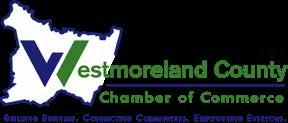
Addressing Pennsylvania’s Child Care Crisis Getting Parents Back to the Workforce
Any working family will tell you that balancing work and parenting is challenging in the best of times. With most young children in Pennsylvania having all available parents in the workforce, child care is critical to supporting the Commonwealth’s labor force and employers.
When parents don’t have the child care they need, it diminishes their work commitments, performance, and opportunities –costing Pennsylvania’s economy billions of dollars each year.
This impact is the focus of a new study from the nonprofit ReadyNation and the Pennsylvania Early Learning Investment Commission. According to the study, gaps in Pennsylvania’s childcare system are costing families, employers, and taxpayers about $6.65 billion annually in lost earnings, productivity, and tax revenue.
These effects are detailed in an economic analysis based on a survey of Pennsylvania working parents with children under the age of five. Survey results showed the various ways in which working parents are struggling with gaps in the child care system. For example: 60 percent of parents surveyed reported being late for work, leaving work early or missing full days of work due to child care problems and nearly half reported being distracted at work. About one-third of parents reported that they changed their work schedule from fulltime to part-time due to problems with child care. More dramatically, 27 percent of working parents said they had to quit their job and 18 percent have even been fired due to child care struggles.
Comparing these results to similar studies conducted in 2018, we see that parents are now facing more negative impacts
due to child care gaps. Parents reported that child care problems had caused them to be demoted six times more often in 2022 than in 2018. Child care availability issues caused parents to have pay or hours reduced three times as often. Turning down a new job offer, missing a full day of work, quitting a job, being reprimanded by a supervisor, and being late for work were all ten or more percentage points higher in 2022 than in 2018. As a result, the economic impact of parents contending with a wider array of problems with child care has almost doubled from $3.5 billion in 2018 to $6.65 billion today.
These results underscore the long-standing difficulties that working families have with finding and affording high-quality child care throughout the state. This is understandable given that nearly 60 percent of residents live in a “child care desert,” an area where there are over three times as many children as licensed child care slots. Additionally, the average cost of infant/toddler care is almost that of public college tuition while less than half of Pennsylvania’s child care capacity is considered high quality.
These problems associated with the child care system are stemming from a historic staffing shortage within the sector driven by low wages. According to a new report from Start Strong PA, the average child care teacher in Pennsylvania earns $12.43 per hour or less than $25,844 per year. The report also showed that approximately 21% of staff rely on SNAP benefits and 21% are insured by Medicaid. This was the case even though most child care teachers surveyed have a college education.
This wage crisis is closing child care classrooms and increasing waitlists for working families. A February 2023 survey of more
than 1,000 Pennsylvania child care providers showed that more than 35,500 children currently sit on wait lists at these locations because of more than 1,500 open staff positions.
Child care providers have been vocal about the fact that they can’t just raise teacher wages because families are already struggling to afford care. They are also hard pressed to compete in this labor market with many sectors offering $20+ per hour for largely unskilled positions. Additionally, providers are contending with rising rents, utilities, and food costs.
These realities are particularly challenging for providers participating in the state’s Child Care Works subsidized program for low-income working families. Historically, these subsidies have not kept pace with the actual cost of providing child care and, despite recent increases, have not adequately kept pace with high rates of inflation.
All of this speaks to the need for the Commonwealth to take direct action to help child care providers recruit and retain qualified educators. Direct investment is needed to boost wages for child care teachers that better reflects the work, experience, and professional degree achievement of these teachers.
Our child care sector is the “workforce behind the workforce.” Teacher shortages, closed classrooms and waitlists will only continue to harm Pennsylvania’s working families and employers, which will cost us billions of dollars annually. We can no longer ignore investing in our commonwealth’s child care infrastructure.
20 GOALMagazine: A Publication of Go2Goal | Summer 2023
Westmoreland Home Mortgage, LLC is a full-service mortgage company devoted to providing clients with fast, personal service and great rates. We provide our clients with quality service, low rates, down payment assistance, experienced loan officers and unique loan products in addition to the standard purchase and refinance of conventional, non-conventional, FHA, VA, and 100% USDA loans.

Our dedicated staff will walk you through the various loan programs we offer to figure out a solution that matches your current financial needs with your long-term goals. With fast closings and competitive rates, we’re the option that’s perfect for people who want a no-hassle home buying process.
Our experts are here to help make mortgages easy...really easy!



21 www.go2goalus.com
JASON L. MCCOY, OWNER NMLS ID 1700607 jason@westmorelandhomemortgage.com WestmorelandHomeMortgage.com 432 Frye Farm Road Greensburg, PA 15601 P: 724.879.4141 • Fax: 724.879.4026 Licensed by PA Dept of Banking With so many options to consider, choosing a mortgage can seem like a daunting prospect. LET US GUIDE YOU THROUGH THE MORTGAGE MAZE
OurFamily Serving Yours
by Maria Graziano-Bickerstaff, Funeral Director
One Way to Take Care of Your Loved Ones When You Are Gone
There are many decisions that need to be made within the first 24-48 hours of losing a loved one and it can be challenging to think rationally during such a difficult time. Pre-planning gives you, and your family, the peace of mind that comes with knowing that your wishes have been recorded and that the details are taken care of.
Planning ahead can range from recording one’s wishes at a funeral home to funding funeral expenses in advance. If you need to alter details after pre-planning, we can help you change your wishes at any time. These arrangements are fully transferable to another funeral home should you decide to relocate in the future.
When meeting with a funeral director to discuss pre-planning, they will ask you a series of personal questions about yourself and the final wishes you have in mind so that they can document your personal funeral plan.
To begin, you will need to gather vital statistics about yourself that a funeral home would need to process a death certificate for your family. The funeral director will also take this time to gather personal information for your obituary, which would include family information, affiliations, hobbies, and interests.
Your funeral director will also ask you questions concerning your funeral service, the participants involved, and your final disposition wishes. Some examples of items that
are discussed at a prearrangement meeting include:
The Funeral Service
• Choice of burial, cremation, or green burial
• Choice of a casket or urn
• Decisions on types and locations of services
• Floral arrangement preferences
• Selection of photographs and memorabilia to display at the visitation
• Music selections
• Arrangement preferences should a death occur out of town
Participants
• Choice of Clergy or Officiant to preside over your service
• Selection of pallbearers
• Choice of family members to read scripture or to prepare a eulogy

Final Disposition
• Choice of a cemetery
• Selection of your burial or cremation plot, mausoleum, or niche
• Choice of a monument
There are many details to consider when discussing funeral arrangements, but remember there is no need to make all the decisions right away when you consider starting the pre-planning process.
If you are interested in learning more about pre-planning, please join us for a Free Peace of Mind Seminar presented by HartmanGraziano Funeral Home, Inc. Our seminar

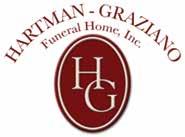
topics are focused on helping answer the frequently asked questions regarding funeral service and pre-planning. Our professionals will be at your service to lend advice and help you with your pre-planning goals.
If you cannot attend our Free Peace of Mind Seminar, please give us a call to receive your complimentary planning guide or to schedule an appointment for personalized assistance in creating your plan.
22 GOALMagazine: A Publication of Go2Goal | Summer 2023
FREE Peace of Mind Seminar Thursday Aug. 17th 6PM at Aroma Italiano 2220 Ligonier Street, Latrobe, PA 15650 A light meal will be served. RESERVATIONS REQUIRED as seats are limited. Call 724-537-5575 or email us at hartmangraziano@gmail.com RSVP by August 11th
Creating and executing an integrated marketing campaign can be challenging, but at Headspace Media, that’s what we do. Recently, the Westmoreland Intermediate Unit contacted us with an exciting opportunity - organizing a remarkable event! They wanted to host a career fair to assist the 17 school districts of Westmoreland County in finding topnotch teachers, custodial staff, and bus drivers. Recognizing the crucial importance of making this event a triumph, they entrusted Headspace Media with handling the event’s marketing and advertising.
We quickly went to work, and lo and behold, the career fair exceeded all expectations! One representative from the Franklin Regional School district even exclaimed that they interviewed more exceptional candidates in a single day than they had encountered in the entire year. Needless to say, our client was overjoyed with the outcome and is eagerly anticipating next year’s event.
How did we manage such a feat? Well, let’s take a look.
Right from the beginning, our talented team at Headspace Media understood the unique challenge of organizing the firstever event, knowing that we had limited historical data to rely on when devising our strategy. To tackle this, we divided our approach into three key areas: Creative, Distribution, and Tracking.
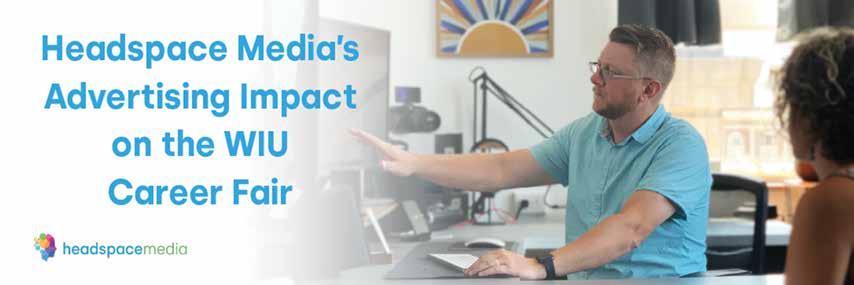
Creative
With a tight timeframe of fewer than 3 weeks to plan and execute the marketing and advertising plan, ensuring a 4-week ad campaign run, we wasted no time. Our creative team delved into extensive research on career fair designs, crafting multiple design options for our client to choose from. Once the client made their selection,
By Matthew Fridg
we brought the chosen concept to life. Once the creative foundation was established, our team designed various versions across social media, print materials, and outdoor displays.
Distribution
Our ads team swiftly sprang into action, collaborating with billboard companies throughout the area to gather essential information. We also took the initiative to set up client accounts on popular platforms such as Google Ads, Facebook Ads, LinkedIn Ads, and Spotify Ads, expanding the reach of our campaign. We crafted a snappy 30-second radio script, professionally recorded by the talented Melanie Taylor from 100.7 FM for a memorable Spotify commercial. Meanwhile, our dedicated account manager meticulously organized the logistics of each billboard placement, working closely with the client to secure contracts for every location, including a prominent digital billboard near the Squirrel Hill tunnels in Pittsburgh. To ensure optimal targeting, we conducted thorough research on detailed demographics and keywords for the digital ads, strategically deploying them across search engines and social media platforms. Throughout the campaign, our team closely monitored performance and budget, making necessary optimizations for the best possible results.
Tracking
Tracking served as the final piece of our comprehensive strategy. Our tech team left no stone unturned, ensuring that tracking scripts from each digital ad platform, as well as the Google Analytics code, were seamlessly integrated into a Google Tag Manager container placed on both the Eventbrite page and the Westmoreland Intermediate Unit website. To accurately trace the sources of traffic leading to the registration page, we employed UTM
parameters for all ad links and the QR codes on print materials. Additionally, we added a “How You Heard” field to the registration form, providing valuable insights into how registrants discovered the event. Furthermore, we created conversion events within Google Analytics, enabling us to analyze the traffic sources of all registrants in a segmented manner. This meticulous effort painted a clear picture of the advertising strategies that proved effective and yielded a positive return on investment.
Results
Upon analyzing the post-event results, it became evident that even though billboards had over 5.76 million total views, Google Ads emerged as the indisputable champion, driving the highest volume of traffic and securing the second-highest number of registrations among all advertising platforms. Impressively, aside from word of mouth, printed flyers emerged as the top-performing advertising medium based on the valuable responses captured in the “How You Heard” form field on the registration page. While Facebook served as the second-best source of traffic, it didn’t result in as many registrations. Following closely behind were organic Google search, Spotify, and LinkedIn, in that order.
The event surpassed expectations. With nearly 200 registrations, the school districts were presented with a substantial pool of potential hires, saving them significant time compared to the traditional application and interview process. We extend our sincere gratitude to Kayla Tamer and Jason Conway of the Westmoreland Intermediate Unit for entrusting us with this project. At Headspace Media, it brings us great joy to help our clients surpass their marketing goals and achieve exceptional results. Visit www.headspace.media to schedule a free 30-minute consultation to see how we can help you.
23 www.go2goalus.com
A PROGRESSIVE AND PRACTICAL APPROACH TO EDUCATION:
Two Local School Districts Color Outside the Lines to Prepare Students for Real Life
Coordinated by Bree Edgerly
When deciding on a place to call home, many families vet the local school districts for successful education programs that boast high test scores and smaller class sizes. Westmoreland County is home to a number of awarded school districts that carry high state rankings and national recognition. Two districts in particular have made a momentous shift in their initiatives to practically prepare students for the future by building opportunities for real world experiences into their K-12 curriculum. Superintendents Michael Porembka of Greater Latrobe School District and Gennaro Piraino of Franklin Regional School District will detail how their districts have taken to heart the mission of developing the whole student and crafting an educational experience that doesn’t just yield high test scores, but truly nurtures students to become productive and creative citizens in their community.
Greater Latrobe School District: Preparing Future Ready Students for the 21st Century
 by Michael Porembka, GLSD Superintendent
by Michael Porembka, GLSD Superintendent
Our relentless focus on academics is showcased through various innovative programs that have been implemented at every grade level throughout our school district. At the elementary level, small group instruction in English Language Arts and Math is an integral part of the school day for all students. Each student’s progress is monitored to ensure academic growth and that all academic needs are being met. STEM remains a focal point at every grade level in not only our elementary schools, but at the secondary level as well, with students participating in project-based learning, such as Project Lead the Way, which is a STEM
curriculum that empowers students to develop and apply in-demand, transferable skills by exploring real-world challenges in an exciting and engaging way. Newly integrated into the elementary schools is the addition of a Spanish curriculum, as evidence shows that early exposure to a foreign language helps children improve cognitive and critical thinking skills while fostering a better understanding of language and cultural awareness. Outside of the classroom, elementary students extend their learning through outdoor play during L.E.A.P. time (Learning Extended through Active Play); a new program designed to spark imagination and creativity as well as encourage teamwork and movement in a nature-focused outdoor environment.
The Greater Latrobe School District’s mission is to prepare students to become lifelong learners and responsible, productive citizens with a relentless focus on instruction and balanced focus on academics, arts, and athletics. Greater Latrobe takes great pride in being a student-centered public school district with diverse course offerings and high academic standards for our pupils. We strive to be progressive in promoting teaching techniques that appeal to the various learning styles of pupils while creating a personalized learning environment that taps into students’ passions and interests, while providing a clear pathway to postsecondary success through which every child achieves his or her potential.

Greater Latrobe fourth grade elementary students work through challenges using electronic building blocks called littleBits as part of our STEM curriculum.

At the secondary level, starting in grade seven, students become acquainted with our five Career Pathways, which is based on the 16 career clusters adopted by the PA Department of Labor and Industry and the PA Department of Education. Every course in our curriculum at the secondary level is aligned to the five pathways, which include:
1) Arts and Communication,
2) Engineering, Manufacturing and Industrial Technologies,
3) Financial, Business and Informational Technologies,

4) Health and Science and
5) Human Services, Hospitality and Public Administration. Students examine their own aptitudes, abilities, and interests, and are encouraged to select courses to pursue a pathway that is well-suited to them with the goal of preparing for their future plans, whether it be college, trade or technical school, workforce, or military.

24 GOALMagazine: A Publication of Go2Goal | Summer 2023
cover story
At the Junior High School, a new unified arts curriculum consisting of 12 trimester electives, will provide students with the opportunity to explore a variety of disciplines and spark their interests in each of the five career pathways, centered around project-based learning, where students gain knowledge and skills by working collaboratively for an extended period of time to investigate and respond to an authentic, engaging, and complex question, problem, or challenge. These electives include courses such as Digital Art, Woodworking Wildcats, Flight and Space, Shark Tank, Stream Study, Law and Order, and more.
the opportunity to meet with teachers for clarification, enrichment, additional help or remediation, eat lunch or explore recreation activities at various locations around our campus. This type of structured independence allows students the opportunity to balance their academic and social needs and prepare for a post high school world full of freedom. Other opportunities to gain valuable pre-employment skills include our own in-house cafe, called Cat’s Cafe, which serves breakfast and coffee daily to students, faculty, and staff. Students hone their entrepreneurial skills in courses like Cat’s Customs - a hands-on, projectbased learning course where students are responsible for running and operating a custom apparel and accessories business. Senior High students are also given the opportunity to get a head start on their postsecondary education by applying for Dual Enrollment, in which certain courses are accepted by local colleges we partner with for college credits.
providing well-rounded opportunities that address all aspects of a student’s education: cultural, cognitive, and expressive. This philosophy is exemplified through our dedication to the arts, including the unique collections of original art that adorn the walls of Greater Latrobe Senior and Junior High Schools and in each of the school district’s three elementary schools. These collections in total house over 200 pieces of artwork and are unique in that they are entirely student-selected and, for the most part, student-purchased. These collections remain an important part of our school district’s culture, while promoting the development of creativity for every student through active involvement in the arts. Greater Latrobe’s tradition of excellence in arts education, in both the visual and performing arts, is a point of pride and remains a point of emphasis in student development.
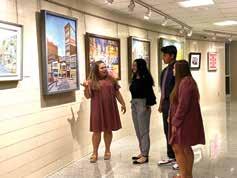
At the Senior High School, students continue their exploration and development through courses aligned with the five pathways model, while taking advantage of programs designed to provide real world experiences, such as our NEXT Career Pathways Program, which connects students with local employers and organizations for job shadowing, internships, work site tours, as well as employment and volunteer opportunities. Cat’s Cash, our student-run credit union located inside the Senior High School, is open for business during the school day, and allows students to open their own savings accounts and begin learning the importance of financial literacy. Lunch and Learn, a one-hour block in the middle of the day, provides students
In addition to our robust academic offerings, the Greater Latrobe School District has always recognized the inherent value of

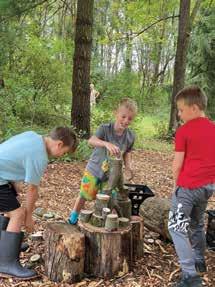
allow kids to grow and expand in different ways that the classroom could never ever offer.”
Overall, the Greater Latrobe School District has embraced innovation and continues to lead the way in offering a diverse variety of educational programs, learning experiences, instructional approaches, and academic-support strategies that are intended to address the distinct learning needs, interests, aspirations, or cultural backgrounds of individual students, all while preparing them to be future ready for the 21st century.
25 www.go2goalus.com
“The musicals performed at Greater Latrobe prepare kids for the real world in so many subtle ways that are often overlooked beyond the simple joys of the fun associated with them. Being on a stage requires confidence and fearlessness, which is something that is hard to teach in a person; rather, it is learned through real-life situations. These performances truly
Jack Dixon, class of 2025
cover story
Greater Latrobe students at Baggaley Elementary School extend their learning outdoors through L.E.A.P., a program designed to spark imagination, observation, teamwork, and creativity.
Greater Latrobe Senior High students in our Cat’s Customs course create and sell custom merchandise while running all aspects of the business, including marketing, planning, operations, accounting, and manufacturing.
Greater Latrobe Senior High students admire an original piece of art adorning the walls of Greater Latrobe Senior High School.
Franklin Regional School District: Portrait of a Graduate
 by Gennaro Piraino, FRSD Superintendent
by Gennaro Piraino, FRSD Superintendent
ment to uphold the 5C’s (Critical Thinking, Citizenship, Creativity, Collaboration, and Communication) in all processes. The FR Ever Skills were created to highlight additional areas of focus to ensure that every Franklin Regional student embarks upon their next step being both career and life-ready.
gain realistic views of their career choices, develop job skills, and interact with adults professionally. The Senior Internship program provides interns with a real-world opportunity to navigate their areas of interest while gaining valuable practical experiences.
The Franklin Regional School Community strives for excellence, learning, achievement, and citizenship in all it does. Since the 2016-17 school year, stakeholders including school board directors, administrators, teachers, parents, students, business leaders, and citizens have worked collaboratively over time to painstakingly build, piece by piece, a future framework designed to support the social, emotional and cognitive growth of all students and prepare future citizens. Using the principles of Human Centered Design, they developed the Franklin Regional “Portrait of a Graduate 2025”, a collective commit-
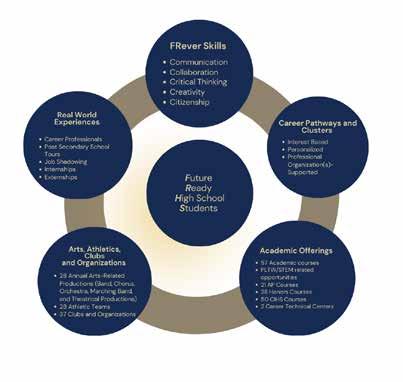
The Franklin Regional School District’s Future Ready Comprehensive Plan addresses the importance of career planning for all students related to labor market projections and workforce needs. This plan aligns with the Pennsylvania Department of Education’s Academic Standards for Career Education and Work. The standards include Career Awareness and Preparation; discovering self-abilities, interests, and relationships; Career Acquisition; Career Retention and Advancement; and Entrepreneurship. The K-12 Counseling Team and associated Advisory Council review and update the K-12 Future Readiness Plan annually. The Plan’s goals for each level (elementary, middle school, and high school) serve as a focus area for the counseling staff as they guide and support students through their academic, career, and social/emotional development.
Franklin Regional School District strives for excellence by providing numerous and diverse opportunities for students to pursue their personal college/career and future goals. The Senior High School has aligned its curriculum and courses with the Career Clusters Framework, enabling students to work with their school counselors to identify possible career clusters (out of 16 total) that interest them and select courses according to their future career goals. Each graduating student leaves their K-12 experience with a Career Readiness Portfolio, a collection of artifacts and documents that reflects their experiences and efforts to foster future-readiness and a potential career path. Opportunities beyond the robust academic offerings include some of the following programs:
Internships/Externships: The FRHS Senior Internship Program allows seniors to
College in High School (CIHS): FR’s College in High School Program aims to ease the financial burden of a college education and the difficulties students often encounter in finishing a college program. Approximately 250 students per year earn college credits through FR’s 7 partner institutions and all state colleges and universities within Pennsylvania’s Higher Education System accept CIHS credits. Additionally, through a combination of College in High School Courses and some dual enrollment courses, students can earn an Associate’s Degree through Westmoreland County Community College.
Career and Technology Centers: Many of the programs at the CTC are SOAR programs which lead students into a career pathway that aligns the secondary courses to a post-secondary program to complete a degree or certificate in over 22 industry areas ranging from Early Childhood Education to Welding.
Health Care Career Exploring Partnership: The FRSD partners with Forbes Regional Hospital and Boys Scouts of America to offer a co-ed program that gives high school students the opportunity to learn about careers in healthcare such as radiology, therapy, nursing, orthopedics, emergency medicine, etc.

cover story
®
A FR fifth-grade student tries his hand at automotive painting under the watchful eye of a high school student while on a visit to the CTC.
26 GOALMagazine: A Publication of Go2Goal | Summer 2023
Equity-Focused Transition and Work Exploration Program: Designed for students with disabilities, the program sends students into the community for real work experience at a variety of placements including UPMC East, Forbes Road Hospital, Barking Babies, Hoss’s, SpectroDolce Confectionary (Autism Employment Network), Shop N Save, Goodwill, Friend’s Thrift Shop and the Food Bank. With exposure to a variety of jobs, the program enables students to build resume experience to gain employment. Additionally, LSS teachers developed a Soft Skills class where students practice in the areas of social skills, interviewing, professionalism, banking, budgeting, money management, problem solving, time management, internet safety, resume development and professional writing.
Partnership with Westmoreland County Forum for Workforce Development: The Forum was developed in 2014 with the objective of better understanding the regional quality workforce needs of business and industry and how improved communication and collaboration can be cultivated and developed between education and business entities to address the needs of the new economy. Students can engage in a Virtual Career Mentoring Program, watch a Career Journeys Video Series, participate in business-led educational collaboratives, and connect with business for internships.
Project Lead The Way (PLTW): PLTW provides transformative learning experiences for K-12 students, immersing them in an
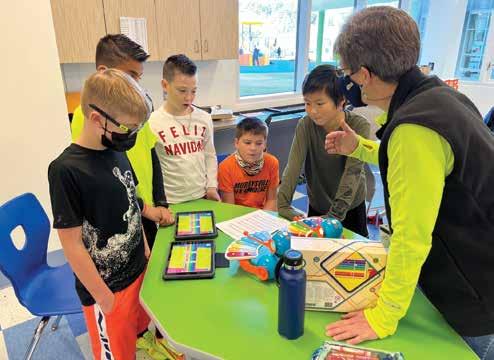

engaging, hands-on classroom environment where they are empowered to develop the knowledge and 21st century skills demanded in today’s workforce. Students are also given the opportunity to explore various career pathways to gain inspiration or reimagine how they see themselves in the future. The K-5 “Launch” program includes three strands: Computer Science that is integrated into STREAM Instruction, and Engineering and Biomedical strands that are taught by science teachers. “Gateway” is the Middle School component that is integrated into the science curriculum with
two separate courses offered in Design & Modeling and App Creator. The Senior High offers four PLTW courses including Principles of Engineering, Engineering Design, Biomedical Science, and Human Body Systems.

Social Entrepreneurship: The “Social Entrepreneurship” course helps to prepare high school students as they research and plan a business venture, understand aspects of business management, and learn marketing strategies. Students gain real-world experience as their projects are tied directly to business or non-profit clients in both the local and regional community. The course develops skills such as organization, backwards planning to meet deadlines, event execution, art/web design and social media management, perseverance to task during times of trial/error, improvement in communication and presentation skills, and the ability to accept and grow from constructive feedback.
Franklin Regional’s Portrait of a Graduate demonstrates the district’s deeply rooted commitment to educating the whole child, identifying the characteristics and skills that students will need to be ready for success in life and establishing common expectations for how the school system will meet its responsibilities of ensuring that students are ready for success.
cover story
A purposeful design component of the FRSH library refresh is the creation of the Panther Cafe that will be used as an additional student operated work experience.
Elementary School students are making music with Dash Robots as part of PLTW.
27 www.go2goalus.com
Students at FRSH toured MSA Safety Company. They engaged with company leaders and team members to get a feel for career options in manufacturing.
Mother Nature’sMagic Wand
Ioften marvel over Mother Nature’s GOAL as she transitions our magnificent part of the country from one season to another. We’re afforded so many opportunities as we move from one captivating season to the next. Summer is filled with an abundance of experiences almost too numerous to count. Then we ease into autumn where we must adjust our activities with the lessening light on our landscape. If we pay attention,
Mother Nature teaches us an important lesson: Embrace the now.
Depending upon your interests, the Laurel Highlands provides a bit of magic in every season. Bursting onto the scene in summer, our bountiful Farmer’s Markets, Outdoor Concerts, the opportunity to visit our seasonal attractions, such as Idlewild Park and Laurel Caverns, captivate our


28 GOALMagazine: A Publication of Go2Goal | Summer 2023
2
1
by Ann Nemanic, Executive Director, GO Laurel Highlands
attention. We hope you plan to populate your calendar with tried-and-true family favorites while introducing something new, like a visit to Historic Hanna’s Town to walk through 250 years of Westmoreland County history.

I firmly believe that travel, whether a short getaway or a long sought-after vacation, should include a blend of fun with a module of learning. Work in a history lesson, a scavenger hunt, a museum visit, a nature hike, a family cooking class. Surprisingly, our brains tuck away those little nuggets that return as fond memories throughout our lifetime. (Laughter is a bonus.)
GO Laurel Highlands is an excellent resource for trip planning. Certainly, we’re here for the millions of visitors discovering and returning to our region on an annual basis. For locals, GO Laurel Highlands will inevitably assist you in uncovering a newfound treasure in your own backyard.





Don’t let the long summer days escape without trying something new… soak up the extended hours that Mother Nature provides with purpose. And, when her magic wand begins to change our landscape from green to red, yellow, and orange, you’ll already have a plan in place to embrace the NOW.

29 www.go2goalus.com
1. Winnie Palmer Nature Reserve
2. Laurelville
3. Idlewild
4. Greensburg Summer Sounds
5. Powdermill Nature Reserve
6. Bushy Run Battlefield
7. Historic Hanna's Town
3 4 5 6
Photo reference:
GOLaurelHighlands.com GOLaurelHighlands.com/events 7
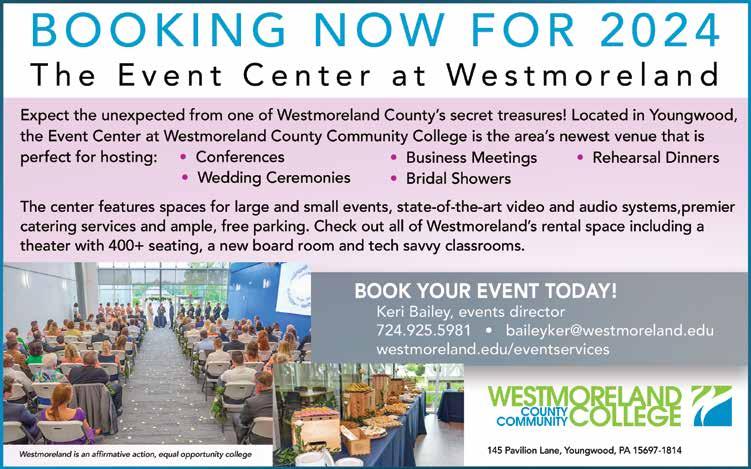


O O y m .
Tips for Downsizing
 Scott Ludwick Associate Broker
Scott Ludwick Associate Broker

Ranked in Top 100 Agents
Nationally Since 1998!
Berkshire Hathaway HomeServices
The Preferred Realty
Everybody has their reason for downsizing. Whether there are fewer people residing in the home or they are just ready for less space, downsizing is a great option. However, there is the elephant – or elephants – in the room. How do you go through all of the stuff that has accumulated in a home? Whether it’s been one year or 50 years, going through belongings that have collected can be a daunting task. Where to start?
Court Ebeling of Carters Home Downsizing and Resale Specialists, has a few tips and tricks after more than a decade in the downsizing business. “Don’t expect to get everything done in one day,” he said. Ebeling advised going from room to room and to start a list of things you absolutely cannot live without. Those items will move with you to your next residence. If you are giving away items to family or friends, set a hard deadline for pickup. For many adult children, their parents’ home has become their storage unit. Set a date for when they have to pick up their belongings and stick to it.
Then, it’s time to go through the rest of your belongings and determine what to sell, donate and keep. Ebeling said to first get rid of anything that is not useful to anyone anymore, whether it is broken, stained or torn, a donation center will not accept it and/or it has no value. While it may be difficult to get rid of a dining room set that once cost thousands of dollars and now a thrift store won’t even take it, Ebeling said, “It’s an economic supply and demand. Most things, like clothing, furniture and knickknacks are worth almost nothing after time is passed. Trends come and go.”
Ebeling advised getting a professional to appraise anything that may be worth money, but for the most part, selling belongings from a downsizing is usually not a cash cow. Old electronics can be recycled.
“People obviously get upset seeing their life go into a dumpster,” he added. “We are trying to let go of things they have loved or enjoyed for many years. But it is time to simplify their lives. We are helping them to get the house better prepared for the market. When buyers come in, they don’t see all the clutter. The house looks bigger, brighter and the process moves that much faster.”
If you have questions about this, or anything real estate relatedreach out to Scott Ludwick at 724-838-3660 or Scott@ScottLudwick.com
Tax Treatment of Selling Collectibles
by Bryan Kisiel, CPA
If you enjoy collecting antiques and collectibles or investing in fine art, wine, or vintage cars, there may be a time when you’re ready to cash in and reap the financial rewards. But you need to be aware of the tax impact of selling your collectibles.
IRS Definition of Collectibles
To serious art and antique collectors, the word “collectibles” often has a negative connotation, conjuring up visions of Hummel figurines, childhood baseball card collections, or your cousin’s long-forgotten high school troll collection. Of course, in some cases, individual items from these collections may be quite valuable; certain vintage PEZ dispensers or Cabbage Patch
dolls, for instance. These would fall under the IRS definition of collectibles under the Internal Revenue Code (IRC), which is as follows:
• Any work of art,
• Any rug or antique,
• Any metal or gem,
• Any stamp or coin,
• Any alcoholic beverage, or
• Any other tangible personal property that the IRS determines is a “collectible”
Gold or silver, or gold and silver exchangetraded funds (ETFs) that are bought and sold, are considered collectible and taxed as such. However, taxpayers should be aware that certain coins and metals are excluded from the IRS definition of

“collectible.” These include any coin issued under the laws of any state or any gold, silver, platinum, or palladium bullion of a certain fineness if a bank or approved nonbank trustee keeps physical possession of it.
As noted above, the IRS has the authority to deem any tangible property not specifically listed as a collectible. So, collectibles could include such items as rare comic book collections, vintage sports cars, baseball cards, or even PEZ dispensers.
Non-fungible Tokens (NFTs)
Recently, the IRS issued preliminary guidance regarding the tax treatment of NFTs (non-fungible tokens) as
32 GOALMagazine: A Publication of Go2Goal | Summer 2023
collectibles and is soliciting comments until June 19, 2023, to determine further guidance. The popularity of NFTs rose during the pandemic, but interest has since waned.
NFTs are defined by the IRS as a unique digital identifier recorded using distributed ledger technology and may be used to certify the authenticity and ownership of an associated right or asset. In simple terms, NFTs represent unique digital assets, typically in the form of visual art, music, and other digital content. They can be bought and sold like any other property and use “distributed ledger technology,” such as blockchain technology, to record transactions and identify ownership.
Collectibles and Capital Gains
The maximum tax rate on net capital gains from the sale of collectibles is 28%. By comparison, the maximum long-term capital gains rate from the sale of an asset such as a home or stocks is 20% (although most taxpayers pay at the 15% rate).
Like other investments, if you sell a collectible after holding it one year or less, you will pay short-term capital gains, which are taxed as ordinary income at your marginal tax rate. To determine how long you held the
asset, you generally count from the day after the day you acquired the asset up to and including the day you disposed of the asset. Depending on adjusted gross income, taxpayers may also be subject to the Net Investment Income tax of 3.8% depending on your adjusted gross income.
There are two ways to figure the taxable basis of collectibles. If acquired through inheritance, the basis is the fair market value (FMV) at the time it was inherited. If the collectible was purchased, the basis is the cost of the item plus any fees, such as the cost of using a broker. The net taxable capital gain is calculated by subtracting the basis from the sale price.
Consult a Tax Professional
Because the long-term capital gains tax rate on the sale of collectibles is higher than that on regular capital gains, strategies such as selling over multiple years to reduce the overall amount of tax assessed on the transactions are often beneficial to taxpayers.
If you have any questions about tax planning for the acquisition and/or sale of collectibles, you should contact your tax professional before initiating transactions to avoid an unexpected tax bill.


33 www.go2goalus.com
... the IRS has the authority to deem any tangible property not specifically listed as a collectible.
The information in this material is not intended as tax or legal advice. It may not be used for the purpose of avoiding any federal tax or tax penalties. Please consult legal or tax professionals for specific information regarding your individual tax situation
Please like us on facebook: Kisiel & Associates, PC Success Is A Journey, Not a Destination Please contact our office if you have any questions or need assistance setting up a budget to meet your business financial goals. 724.626.2926
Bryan Kisiel, CPA CEO, Kisiel & Associates Director of Tax Planning, SecondHalf Coach Wealth Management
by Autumn Stankay, Owner and Photographer of SkySight Photography
A Photographer’s Guide to
In February, I traveled to the west side of Maui to explore, capture, and photograph the area. I also helped film a documentary about recording the sounds of nature with my husband, Bill. I wanted to share some of my favorite places I photographed, so if you are planning to visit Maui, you can use this guide to help you plan your trip!
Winter in Maui, specifically late January and early February are peak seasons for breeding humpback whales.

M AUI
34 GOALMagazine: A Publication of Go2Goal | Summer 2023
The goal of our trip was to capture the whale sounds with a hydrophone for a musical project that my husband Bill is creating. (For more about this project and extensive Maui tips visit the link at the end of this article). We’ve done whale excursions in three different oceans, but I was not prepared for the sheer number of whales we would see in the basin off the west coast of Maui. They are on the horizon in every direction you look. Do not skip out on seeing this once in a lifetime experience if you travel to Maui in the winter months. My recommendation for a whale watching company would be Ultimate Whale Watch - they are eco friendly, respect the rules and regulations of the whale reserve and are also affordable. Whoever you plan to tour with, be sure to ask them if they have a hydrophone so that you can listen to the singing whales. (More information on whale songs in my blog link at the end).
PHOTOGRAPHY TIP: Have a zoom lens on your camera, because unless the whales choose to come toward the boat on their own, the boats cannot approach the whales closer than 100 yards.



Lahaina - I suggest staying near this location for accessing most of the island mentioned in this article, as well as getting on the boat to visit the whales. Another Lahaina bonus is that you can see whales spouting and breeching from the beach and shore any day, anytime. We spotted many just driving along the coast. A few things that are very close to Lahaina are Dragon’s Teeth, Kapalua Coastal Trail, the Honoapiilani
Food Truck Park, and the amazing jungle trees at the Honolua Bay Access Trail.
You’ll hear a lot of buzz about driving the Road to Hana. But if you don’t have the time to do so (it takes all day), another wonderful day trip by car is the Road to Kahakuloa. There are many beautiful overlooks, and you can add stops at the Nakalele Blow Hole, Karen Lei’s Gallery, and the Waihee Ridge Trail. I suggest taking the southern half of the loop along RT 30 to start at Waihee Ridge, then return to Lahaina via the switchback northern half of the circle.


Every beach is simply amazing! They are all so different. Baby beach was loaded with sea turtles! Slaughterhouse Beach was simply gorgeous and very natural. Kaanapali Beach was beautiful too!
PHOTOGRAPHY TIP: Bring an underwater GoPro to capture the turtles! Remember to give them their space and never touch them while snorkeling. We snorkeled right at the beach, no need to pay for an excursion!
The Road to Hana is amazing! However, it does take time to just get to the start of the road from Lahaina, plus the drive is slow and has many switchbacks. If you plan to do this, be aware that you should start your day at sunrise and expect it to take until sunset. If you don’t want to travel the entire road, you can see some great places in the first 15 miles, then turn around and return to Lahaina! Here is a short list of a few great stops in that beginning stretch: Twin Falls, Garden of Eden Arboretum, Waikamoi Nature Trail, and the Eucalyptus Rainbow Trees. Remember, locals live on this road, so be sure to respect their driveways and all travelers on the road, not all are tourists.
Photography tips: Stroll through Garden of Eden with a camera to capture every flower and plant you can imagine that Hawaii has to offer. Also, practice slow exposures on the many waterfalls on this road to get that soft streaming look of the rushing water.


The last location I would highlight is Haleakalā National Park. I felt pure magic when watching the sunset from atop this volcano. It’s truly something I will never forget. I suggest leaving Lahaina around 1pm for this trip. It will take you a few hours to drive from Lahaina to the top of the volcano. You’ll want to arrive at the top at least 1 hour before sunset, possibly earlier if you want to park at the summit and/or walk around to explore a bit. Capture the sunset from this point - you’ll be above the clouds and watch the most magnificent display you could imagine. After the sun has set, make your way back to your car and take a rest for a few minutes. Let the other cars rushing off the peak go ahead of you and enjoy the ride down without traffic. This gives you a chance to let the stars come out for a bit before you leave the mountain. It is the densest display of stars I’ve ever seen. Plan to pull over at an overlook and get out of the car to take it all in.

PHOTOGRAPHY TIP: Arrive there early for the sunset and bring a tripod if you like star photography!
Before going to Hawaii, it is important that you do some research on the best ways to respect the culture, locals, and the rich history. The Hawaii Vacation Guide is a wonderful resource written by a married couple who lives there. They not only have the best guides on what to do, they also have great tips on respect for Hawaiian culture.
www.thehawaiivacationguide.com
To read the full version of this article with more details and information, visit www. skysightphotography.com/blog
35 www.go2goalus.com Explore my galleries for more! www.skysightphotography.com

 by Jason Rigone, WCIDC Executive Director
by Jason Rigone, WCIDC Executive Director


Partnerships Key to Economic Development Efforts
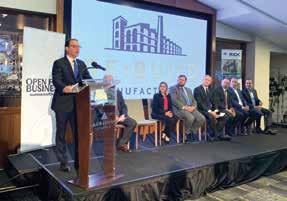



This spring, the Westmoreland County Industrial Development Corporation announced that it was joining forces with Regional Industrial Development Corporation (RIDC) to redevelop, operate and manage a nearly 70-acre industrial site with a manufacturing legacy that goes back more than 130 years.


It’s a big project. The facility — New Kensington Advanced Manufacturing Park (NKAMP) — has 20 industrial buildings that contain more than 1.1 million square feet of leasable space, and this former Alcoa site has a history that is intertwined with the development of the Alle-Kiski communities surrounding it. Local residents recognized the importance of the complex; when the property’s future was uncertain in 2018, the Redevelopment Authority of the City of New Kensington purchased this asset with hopes that it would once again become a catalyst for economic growth.
The redevelopment authority had the foresight to preserve the complex, but the reality is that it would be an extremely heavy lift for any local agency to tackle a redevelopment project of this scale. To free up its resources for other worthy projects while also accelerating the NKAMP timeline, the redevelopment authority reached out to the county. And we started talking amongst ourselves and with our economic-development colleagues and state officials.
We’re fond of saying that economic development doesn’t happen in a vacuum, and this project is a perfect example of that. Without the help of numerous partners, this WCIDCRIDC joint venture — which, as this article goes to press, is nearly finalized — wouldn’t have happened. Governor Josh Shapiro, Senate President Pro Tempore Kim Ward, Senate Majority Leader Joe Pittman and the Westmoreland House delegation led by Representative George Dunbar provided
strong leadership at the state level that was essential to getting this done. The Richard King Mellon Foundation contributed generous support, and of course Re:Build Manufacturing — the “private” in this public-private partnership — played a key role, as well. Re:Build, which is investing $50 million and will occupy 175,000 square feet of the complex, has committed to creating 300 high-paying advanced manufacturing jobs.
The WCIDC is celebrating our 40-year anniversary this year, and we take pride in our track record of successfully working with others to strengthen the Westmoreland economy. Here’s a few examples of projects we’ve tackled with the help of others:
• We partnered with Penn State New Kensington on The Corner, its center for entrepreneurial learning in downtown New Kensington, and we served in an advisory role for the Digital Foundry at New Kensington advanced manufacturing training center that PSNK, Economic Growth Connection of Westmoreland and Richard King Mellon Foundation founded.
• With local, county, state and federal support, we collaborated with the state Department of Environmental Protection to redevelop and remediate environmental concerns at the former home of Jeannette Glass. The property was later sold to Elliott Company, which build a $60 million cryogenic pump test facility on the land.
• We collaborated with eight partners at local, county, state and federal levels to raze the condemned former Monsour Medical Center along Route 30 in Jeannette and to perform environmental remediation and siteimprovement work.
• We collaborated with Tenaska on its project to develop its 925-megawatt power plant (Tenaska Westmoreland Generating Station) in Smithton.
• When Lennox announced that it was closing its stemware crystal factory in Mount Pleasant in 2001, we partnered with Economic Growth Connection of Westmoreland to take over and manage the facility and transform it into a multi-tenant building.
• And, in our first collaboration with our NKAMP partner, we worked with the state and RIDC to redevelop the former Sony and Volkswagen plant into the multitenant RIDC Westmoreland.
You’ve probably heard the saying “many hands make light work.” Over the years, we’ve learned just how true that is. By working with such great partners, the WCIDC doesn’t put all of our eggs in one basket, so we’re able to continue making multiple strategic investments throughout Westmoreland County to spur economic development, foster job growth and help create a stable tax base.
37 www.go2goalus.com
For additional details, visit westmorelandcountyidc.org and follow us on social media
Victor Mroczkowski, Re:Build Manufacturing executive vice president, points out building details while leading a tour of Re:Build’s future home at New Kensington Advanced Manufacturing Park.
During the May 1 Re:Build announcement, Gov. Josh Shapiro declared that Pennsylvania was open for business. The Commonwealth is one of several partners in the New Kensington Advanced Manufacturing Park project.
Leadership Greater Latrobe Completes the Inaugural Year with a
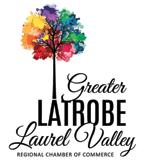

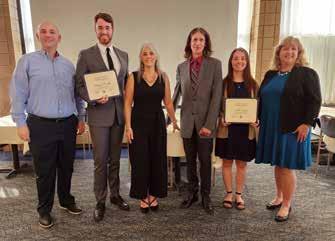
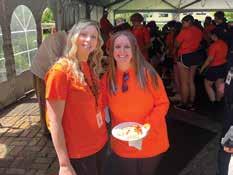 by Briana R. Tomack
by Briana R. Tomack
Bang!
The Greater Latrobe-Laurel Valley Chamber’s inaugural class of Leadership Greater Latrobe just finished up its first year with a bang! For their required team project to complete the class, our group envisioned fulfilling the chamber mission of connecting business, community and education. To begin the project, the team contacted Jessica Yetter, The NEXT Career Pathways Coordinator at Greater Latrobe High School. Together, they began to brainstorm how they could educate the students in the school district about the great businesses that reside in the downtown Latrobe area. The team believed that, for the most part, many students in our area are not aware of the downtown business district, maybe never having ventured off of the route 30 corridor for more than a few excursions to Legion Keener Park, or perhaps the Latrobe Art Center. The question was, how can we bring many students and teach them about many businesses in a short period of time? The answer was, of course, a field trip! Not just any field tripwe needed it to meet the objectives of the Career Pathways program, as well as fulfilling the Chamber’s mission. WIth Jessica’s assistance, the team made a comprehensive list of businesses in the downtown area, and then divided them into 5 career pathways. Then the group began contacting business owners to brief them on the project and gauge their interest in participating. The business owners and community leaders couldn’t have been more thrilled to
participate and engage our young students. Armed with this information, they began to create a passport book, complete with maps for each career pathway. Each pathway had several businesses to visit and learn about. Students selected the pathway they were most interested in learning about. In addition, all students visited many Latrobe landmarks, including the new interpretive sign located at the entrance to the city via the 981 bridge, the Veterans Memorial, the Banana Split historical marker, and the Fred Rogers statue in James H. Rogers Park. The students were also treated to a break with snacks at the Greater Latrobe Laurel Valley Chamber of Commerce Neighborhood Visitors and Information Center and The Paper Heart Social Goods and Event Studio before being treated to lunch at the historic DiSalvo’s Train Station Restaurant topped off by original Valley Dairy Banana Splits!
We would like to thank Jim and Michelle Teague from A Teague of Your Own for teaching the John Maxwell Leadership principles to our class; all of our monthly speakers who come from all businesses throughout Westmoreland county; Jessica Yetter and the entire GLSD administrative team and teachers for coordinating this massive effort; DiSalvo’s Station and Valley Dairy for the great lunch; our inaugural class of Leadership Greater Latrobe participants for creating what will be an annual field trip for the students; the businesses who participated in the event; and, of course, the students for their interest and enthusiasm for the project!
For me, as the Chamber CEO, this project made a long-standing wish come trueto see our students introduced to our businesses and downtown community. The barriers that had previously existedtransportation, time out of class, etc…- were all resolved through the teamwork of so many. It truly was a sight to see, and one that will continue for many years, we hope!!
Congratulations and thank you to our LGL team, Michael Tusay, Anthony Massetto, and Katie Byers. Home run!!
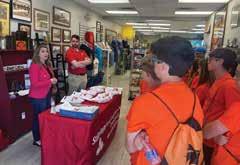
38 GOALMagazine: A Publication of Go2Goal | Summer 2023
Students in the Finance/Business Services pathway at The GLLV Chamber learning about insurance from Sarah Crispin-Thomas, State Farm Agent.
Lunch under the tent.
Briana R. Tomack Greater Latrobe Laurel Valley Chamber of Commerce President PO Box 463, Latrobe, PA 15650 724-537-2671
www.latrobelaurelvalley.org
LGL Graduation-Jim Taegue, Anthony Massetto, Briana Tomack, Jeff Minkovich, Katie Byers and Michelle Teague. Not pictured, Michael Tusay.


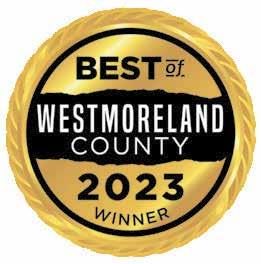
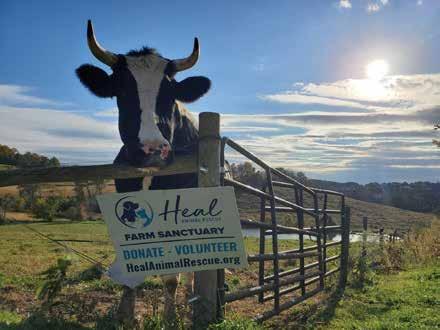

39 www.go2goalus.com HOURS: Monday: CLOSED Tuesday - Friday: 11am to 6pm Saturday: 11am to 5pm Sunday: 11am to 5pm ADOPT • DONATE • VOLUNTEER Place to Volunteer A voice for those who cannot speak 216 Depot St, Youngwood PA 15697 (724)925-2555 healanimalrescue.org
What's Going On With My Rates?
The world has changed drastically over the last three years. Labor and parts shortages are consistent, inflation is at an all-time high, and mortgage rates are knocking on 7%. At this point, we are all just trying to survive one day at a time.
To add to the stress, have you received your auto or home insurance (or for that matter any insurance policy) renewal yet this year? If you did, my guess is you nearly had a heart attack over the premium increase. But why the big increase in premium? In order to find the answer, we need to understand the insurance industry as a whole.
How Does Insurance Work?
In its simplest form, an insurance company is in the business of paying claims. That’s it! The overall goal is to collect premiums, pay claims, take care of the day-to-day bills, and still have a little left over.
Insurance functions on the law of large numbers. Insurance companies reduce the risk of loss by pooling together data from

large groups of people. A company begins by analyzing statistical data about people, businesses, or groups and to what degree of risk it holds that may result in a loss. Once this is determined, they begin to develop a base rate to charge their customers while in return promising to pay a claim that may arise. When we talk about these rates they are explained as charging X dollars per thousand.
Example: If I insure a $10,000 diamond ring the base rate is $9 per thousand which equals an annual premium of $90.
Your premium is then added, or pooled, to that carrier’s other insureds. This pot of money pays for all claims of the company’s insureds. At the end of the day, the overall hope is that the company made the correct underwriting decisions to conduct a profitable business. Typically, a claims ratio breakeven point for an insurance company is around 60%. This means that a company must not pay out more than $60 for every $100 collected to remain profitable and continue protecting their policyholders.
Claims, the World, and Rates
Whatever you insure, there is always a cost associated with making you whole again, which is the purpose of insurance. Those costs may be for the lumber needed to frame your new roof after a fire, paint needed for your car’s new fender after hitting the post in the bank parking lot, or your medical bills. No matter the item, that service or product has most definitely increased in cost over the past few years.
In order to stay competitive during these challenging times, insurance companies have increased rates slightly but have not made drastic changes. In the short term, this is an effective solution to grow the company. However, inflation has run rampant faster than any policy could keep up or anyone could imagine. Claims ratios are now well exceeding that 60% mark. Companies are seeing the poorest results in history. State Farm recently announced a historic underwriting loss of over $13 billion in 2022; almost three times higher than their 2021 losses largely in part because of inflation driven costlier auto
40 GOALMagazine: A Publication of Go2Goal | Summer 2023
by JJ Rettura, CIC Vice President/Operations Manager
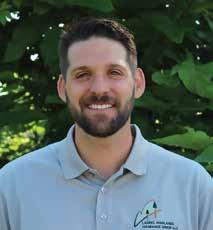 Laurel Highlands Insurance Group LLC
Laurel Highlands Insurance Group LLC


insurance claims. Recently, they stopped writing new home insurance policies in California due to the extreme loss ratios caused by increased building costs and increase in wildfires.
As companies begin to feel this stress and financial struggle something must give. This is where your rate comes in. To try to offset the losses and bring the claims ratio down, a company will begin to increase overall rates which are passed on to you and me as insureds. Great, isn’t it?
What Can You Do?
It’s no fun being on the inflationary receiving end of an insurance company’s losses. But honestly, it’s not 100% their fault. It is the raging inflation, post-pandemic ways of life, governmental decisions, insurance fraud, and more. Those are topics for another day.
What is important however, is you can do a few things to help control your costs. There are two schools of thought. The first one involves cutting all costs but jeopardizing your coverage. The other is where you trim the fat without putting yourself in a possible situation. This is the better choice whenever possible.
Cutting all costs means you reduce all your coverage to the bare minimums, remove extra endorsements, raise deductibles as high as they can go, and opt in to accepting market value for any claim that may be paid. If times are tight, this option will save you the most money but beware, it also puts you at the highest risk. Reducing the coverage limits and removing endorsements could lead to a claim not being paid or not fully paid. If a claim cannot be paid fully by the insurance company due to your chosen low limits, it is you who then becomes financially responsible for the balance. This can result in a lifetime of payments, bankruptcy, or heavy debt, leading to even harder financial times.
The best option is to trim the fat where you can without giving up too much coverage. The first place to start is with increasing the deductible. A higher deductible will always result in a lower premium because you agree to take on more of risk. Next look at your endorsements. No matter what type of policy you have there are always “extras”. These valuable options are great, and often they protect specific items or a specific type of loss, but they may be options you feel comfortable without. After reviewing how these extras work and what they cover, you may be able to reduce or
remove them without assuming a lot of additional risk. Often, you can give up a little without sacrificing too much. Next, check with your agent to verify you are receiving all the discounts you qualify for such as multi-policy, safe driver, good student, premises alarm, multi-car, and more. Lastly, review your main policy coverage. This should be your very last resort. I do not recommend you decrease coverage in this area. By doing so, you may put yourself in a very tight situation, exposing yourself to coverage gaps and the possibility of extreme financial pressure.
What’s Next?
Right now, just be patient and ride it out. Do what you can to help your pocket and search around for the best rates. But be careful, don’t sacrifice your protection. If inflation is on the rise, undoubtedly so are insurance rates. Do your due diligence when looking for a company that fits you and your needs. At Laurel Highlands Insurance Group, we provide you with the best service possible at competitive rates. I know it’s been a difficult few years, but hang in there, we are in this together. It will get better.
41 www.go2goalus.com
Laurel
Highlands Insurance Group LLC 724-437-2371 info@laurelhighlandsins.com
If you would like to review your existing home or auto insurance policy or would just like a completely unbiased review, we would love to help. Laurel Highlands Insurance Group LLC is an award winning, premier, multi-lines, independent insurance agency in the heart of Southwestern PA with decades of experience. We take great pride in providing our clients with fair and honest information so they can make the best decision possible for themselves and their families. It’s our goal to leave you with a better understanding of your risk and provide you with the protection to match. Please contact us by phone, email, or by scanning the code.
*Coverage
options vary with insurance company, type of policy, and options purchased. Please consult your insurance professional for answers specifically related to your policy. Coverage included in this article is specific to Laurel Highlands Insurance Group LLC and the companies it represents.
Understanding the Many Choices in Healthcare

Health insurance can be very complex and challenging to navigate. In this article, we’ll take a look at the different types of insurance available, including major medical, indemnity plans, PPOs, HMOs, and more.
by Allison Clayton
To start, let’s take a look at why there are so many confusing options when it comes to healthcare. Unlike some other countries with single-payer or government-run healthcare, our system has many stakeholders, including insurance companies, healthcare providers, employers, and government programs. This creates a competitive marketplace where players offer different plans to attract consumers.
That puts healthcare in an unusual position, one where delivering a variety of choices collides with a complex regulatory framework at both the state and federal levels. Coverage requirements, consumer protections, and insurance standards often vary from state to state.
Other pressures on the system include rising healthcare costs and technical innovation. While the US does have some of the highest healthcare costs in the world, both the government and insurance companies keep looking for ways to manage costs. And as new technologies and treatments are developed, they must be merged into this already complicated system.
While a wide range of choices can be overwhelming, they exist to provide individuals and employers with options that meet their personal healthcare needs and financial circumstances, along with the freedom to choose what
works best for them. Of course, it’s important to carefully evaluate your options, understand terms of coverage, and consider factors like cost, provider networks, and individual health requirements when deciding which healthcare insurance to buy.
Major Medical Plans
When people think of health insurance, they often mean Major Medical Plans, also known as comprehensive or traditional health insurance. Key features of these plans generally include:
● Deductibles— the amount you pay out of pocket before your insurance coverage begins.
● Coinsurance— the percentage of costs you are responsible for after your deductible is met.
● Out-of-Pocket Maximum— the maximum amount you personally must pay in a given year.
● Network Providers— a group of healthcare providers who have agreed to negotiated rates with your insurance provider. In the network, you get the highest level of coverage at the lowest cost.
These plans are designed to provide coverage for a wide range of medical expenses, including hospital stays, surgeries, prescription medications, and preventive care.
Indemnity Plans
Indemnity plans, also known as fee-forservice plans, provide more flexibility in choosing healthcare providers, along with some related benefits.
With an Indemnity Plan, you often have a wider selection of doctors, hospitals, and services to choose from, and you don’t need preauthorization or a referral from your PCP to see a specialist. With indemnity plans, the insurance company pays a predetermined percentage of “reasonable and customary charges” for a given service, and the insured pays the rest.
One thing separating Indemnity Plans from Major Medical is that you pay for your healthcare services upfront, then submit a claim for reimbursement. This can be useful in some situations, mainly where you prefer to negotiate prices directly with your doctor or hospital.
On the downside, you have to be completely aware of what your healthcare provider is charging, as you may be on the hook for charges not covered by your insurance plan.
Preferred Provider Organization
PPO plans offer a network of healthcare providers who have agreed to provide services at discounted rates to plan members. PPO plans generally allow members
42 GOALMagazine: A Publication of Go2Goal | Summer 2023
to see both in-network and out-of-network providers, but your costs are typically higher for out-of-network care.
How is a PPO plan different from a Major Medical plan? In many respects the two types of plans are very similar. They both have deductibles, co-payments, and coinsurance, as well as in-network and outof-network coverage.
Preferred Provider Organization plans, as the name suggests, are known for emphasizing a convenient network and flexibility of choice, such as the idea that you can seek out-of-network care without a referral.
Health Maintenance Organization
HMO plans typically require members to choose a primary care physician (PCP). This doctor delivers preventive care, manages chronic conditions, and can refer you to a specialist when you need one. The goal is to ensure your healthcare is monitored by someone familiar with your situation and focused on your specific needs.
When it comes to specialists, HMOs usually require a referral from your PCP, but with some of our local Medicare Advantage HMOs, it is not always required.
HMO plans offer lower out-of-pocket costs but have more restrictions on seeing out-of-network providers. HMOs often emphasize preventive care, including vaccinations, screenings, and wellness programs. These services are typically covered at little to no cost, encouraging members to maintain their health and catch potential health issues early.
Point of Service Plans
POS plans are a combination of HMO and PPO plans. With this type of insurance, you benefit from reduced costs when you choose in-network providers, but unlike HMOs, you have more flexibility
out-of-network. Additionally, while HMOs require a referral from your primary care doctor for specialist visits, POS plans give you direct access to specialized care.
Exclusive Provider Organization
EPO plans are similar to both HMO and PPO plans. Like HMOs, EPOs have exclusive networks, which means they are usually less expensive than PPOs, but as with PPOs, you’ll be able to make your own appointments with specialists.
Another difference from a PPO plan is that members usually do not need to choose a primary care physician. EPO plans are typically great for healthy individuals who can benefit from lower premiums compared to other plans. But you have to be willing to stay in-network.
High Deductible Health Plans
HDHP plans have high deductibles and low premiums. They are usually paired with a Health Savings Account (HSA), which allows you to save pre-tax money for medical expenses. HDHP plans are great for the young and healthy, those with no chronic conditions. They can lower their healthcare expenses as long as they are ready to shoulder more costs if a medical need does arise.
Catastrophic Health Insurance
Catastrophic plans are designed to provide coverage for severe medical events and have lower premiums but higher deductibles. These plans typically have limited coverage for routine care and are primarily intended for young and healthy individuals.
If you are in good health, have no chronic conditions, and mainly need coverage for unexpected medical emergencies or catastrophic events, this type of insurance can provide financial protection while keeping premiums low.
Why Work with Allison?
Being an independent insurance agent working with Insurance Services, LLC, Allison can offer a variety of plans so there is no bias when we recommend Major Medical, an Indemnity Plan, High Deductible Plan, or others. Our goal is to serve you best.

“We are licensed with various insurance carriers, so their rates are at our fingertips to compare instantly, and we can access the different insurance carrier rate history over the years, have familiarity with their customer service, and website portals.”
“After we develop a needs analysis that reviews your medication, doctors, and the benefits that are important to you, then we work to narrow down some plans that are right for you.”
Allison Clayton is a PA licensed health and life insurance broker, NPN - 16724709. We are not affiliated with or work for the federal government or Medicare program. We do not offer every plan available in your area. Any information we provide is limited to those plans we do offer in your area. Please contact medicare.gov or 1-800-medicare to get information on all of your options.
43 www.go2goalus.com
Visit Allison’s website at https://www.insuranceallison.com/. She can answer all your Medicare questions and keep you on the right track! There is also a website scheduling option at her website: https://www.insuranceallison.com/request-an-appointment/
phone, and virtual appointments.
Allison Clayton is available for in-person (if needed),
If you would simply like a quick phone review, you can call anytime at 724-879-5030.
4th Annual
Gala
After a three year hiatus, the GOAL Magazine Gala made its return to Greensburg Country Club to raise funds and bring awareness to a local charity that helps children who were a victim of a crime or unfortunate circumstances to have the opportunity to go shopping with a police officer right before Christmas. Shop with a Cop helps to establish a positive relationship with law enforcement in local youth, taking approximately 500 children in Westmoreland County Christmas shopping each year. With the help of everyone that attended, sponsored, donated and volunteered, the 4th Annual Gala raised enough funds to send 148 children Christmas shopping in 2023.
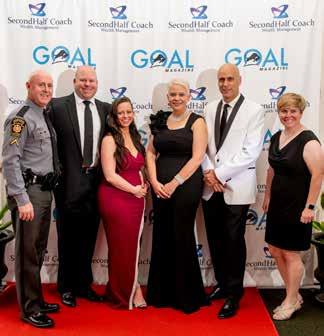
Upon arrival, guests posed for photos on the Red Carpet captured by the one and only Autumn Stankay of SkySight
 by Tawnya L. Rockwell
by Tawnya L. Rockwell
Photography, then savored champagne punch and hors d’oeuvres as they bid on auction items to win great prizes including an autographed “Rudy” jersey and football. After entering the Grand Ballroom, guests enjoyed the sounds of electric violinist Steven Vance, DJ Christopher Castiglione and a four hour top shelf open bar with two specialty drink stations including a Moscow Mule station and Martini Luge. Food stations included Mussels and Carved Oak Barrel Steak followed by a full dessert display donated by local bakery, Heart and Soul Cookies and Pastries. The rest of the evening was full of dancing, posing in the photo booth with law enforcement props and playing black jack, roulette and craps for a chance to win the grand prize basket valued at over $500 that was full of gift cards to numerous local restaurants, wine, liquor and more.


Representatives from GOAL Magazine and SecondHalf Coach Wealth Management present the founder of Shop with a Cop, Stephen Limani with a check for $22,200. Photographed from left to right: Jessica Geary, Bree Edgerly, Amanda Mayger, Public Relations Manager and Pennsylvania State Trooper Stephen Limani, Tawnya L. Rockwell, Anthony Slezak and William Urbanik.

44 GOALMagazine: A Publication of Go2Goal | Summer 2023
Magazine's
Members of Law Enforcement that attended the 4th Annual GOAL Magazine Gala pose for a photo on the Red Carpet.
SeeNextYouYear!
LEAD SPONSOR
SecondHalf Coach
Wealth Management
GOLD SPONSORS
SAVE THE DATE: Friday, April 12, 2024 for our 5th Annual GOAL Magazine Gala benefiting Shop with a Cop.
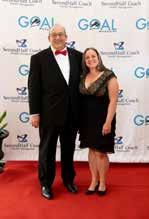






THANK YOU TO OUR EVENT SPONSORS:
SILVER SPONSOR Laurel Highlands Insurance Group
BRONZE SPONSORS
Elite Tactical Firearms Training
Platinum Salon & Spa

Disaster Restoration Services
Robindale Energy
Team Steve Limani Realty One Group Gold Standard
Westmoreland Chiropractic & Rehab Associates
BAR SPONSOR
Rafferty Legal
MARTINI LUGE SPONSOR
Kisiel and Associates, pc
MOSCOW MULE SPONSOR
The Melissa Merriman Team
RED CARPET AND PHOTOGRAPHY SPONSORS
SecondHalf Coach
Wealth Management
SkySight Photography
PHOTO BOOTH SPONSOR
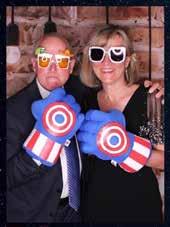

Mullen Refrigeration Service
HORS D’OEUVRES SPONSOR

Westmoreland County Commissioner, Gina Cerilli Thrasher
CHAMPAGNE PUNCH RECEPTION SPONSORS
Central Westmoreland Habitat for Humanity
WATT Fuel Cell
DESSERT SPONSOR
Heart and Soul Cookies & Pastries
COFFEE SPONSOR
William Penn Self Storage
INVITATION/TICKET SPONSOR
Fotorecord Print Center
HI TOP TABLE SPONSOR
Windswept Entertainment and Event Rentals


MEDIA SPONSORS
Greater Latrobe Laurel Valley Chamber of Commerce
Westmoreland County Chamber of Commerce
Blue Sky Sign Co.
Photo credit Skysight Photography.
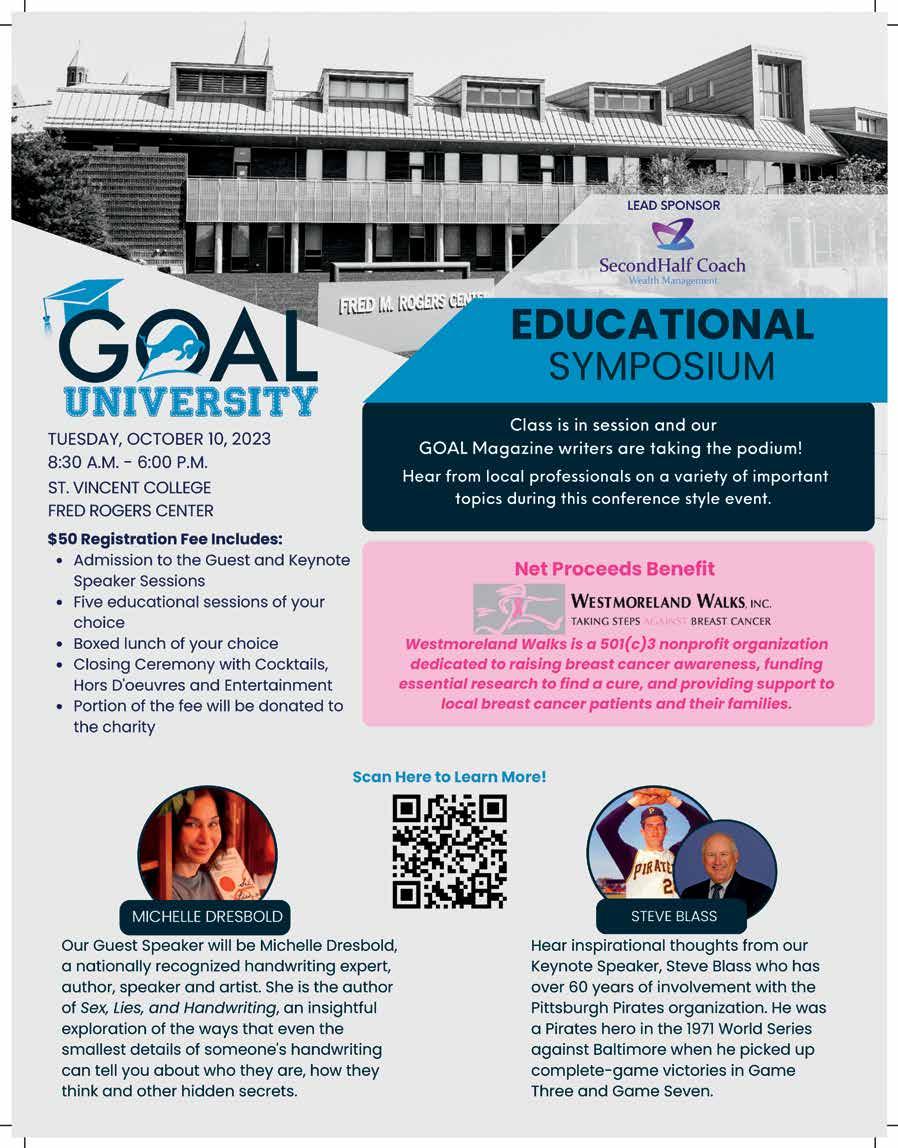
P.O. Box 304, Latrobe, Pa 15650





724-209-8219
go2goalus.com

info@go2goalus.com
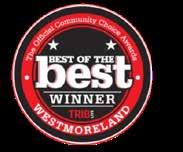

Content provided in GOAL Magazine is for educational, informational, and promotional purposes only. GOAL Magazine does not render professional advice. Recommendations expressed in articles have not been independently tested. Articles contained in GOAL Magazine reflect the perspective and advice of their authors, not necessarily the magazine's publisher. GO2GOAL is a Pennsylvania not-for-profit organization with a 501(c)3 status with the Internal Revenue Service. The official registration and financial information may be obtained from the PA Dept. of State by calling toll free within PA at 800-732-0999.

© 2023 Go2Goal

MAGAZINE
724-537-7203
Heating & Cooling
10 Year Warranties
Free & Friendly Estimates
Emergency Service Findoutforyourselfwhy morepeoplecallMullen for their comfort needs! 724-537-7203 www.mullenrefrigeration.com
•
•
•
•





































 by Jessica L. Rafferty, Esq.
by Jessica L. Rafferty, Esq.










 by Nicole O’Barto-Trainer, Ph.D., MS, LPC
by Nicole O’Barto-Trainer, Ph.D., MS, LPC





























 by Michael Porembka, GLSD Superintendent
by Michael Porembka, GLSD Superintendent







 by Gennaro Piraino, FRSD Superintendent
by Gennaro Piraino, FRSD Superintendent
















 Scott Ludwick Associate Broker
Scott Ludwick Associate Broker














 by Jason Rigone, WCIDC Executive Director
by Jason Rigone, WCIDC Executive Director







 by Briana R. Tomack
by Briana R. Tomack







 Laurel Highlands Insurance Group LLC
Laurel Highlands Insurance Group LLC





 by Tawnya L. Rockwell
by Tawnya L. Rockwell




















